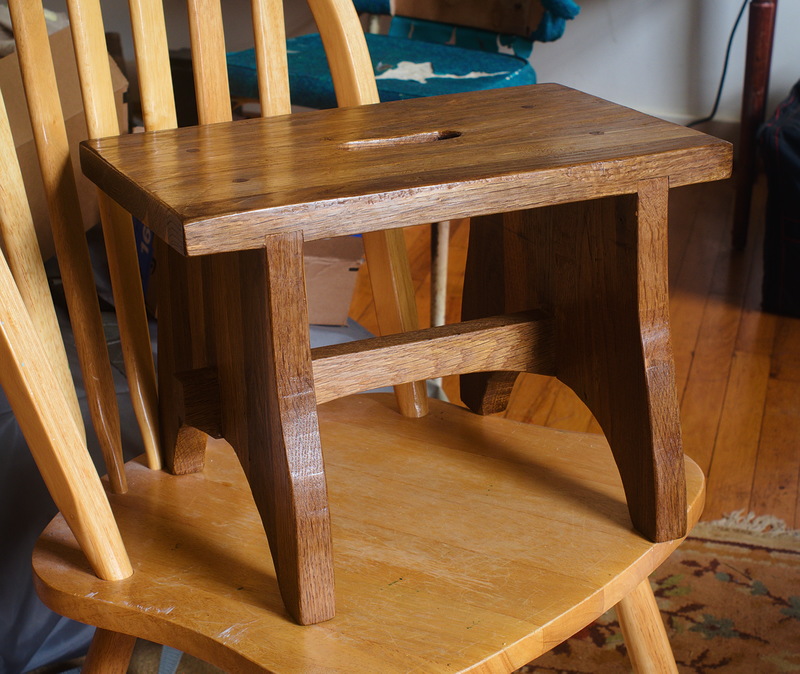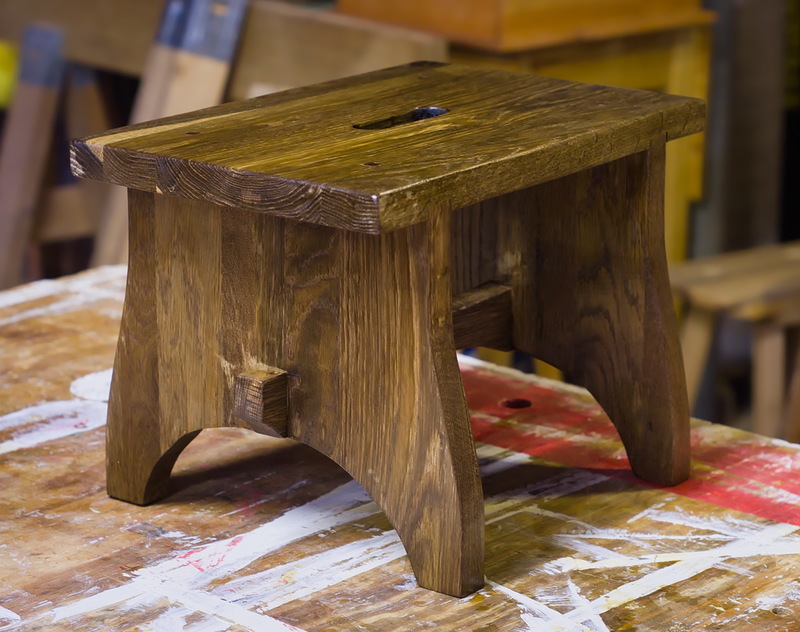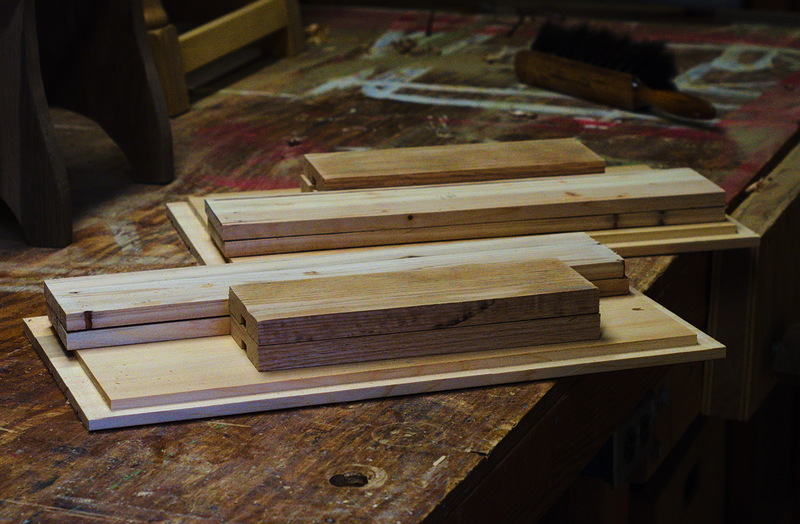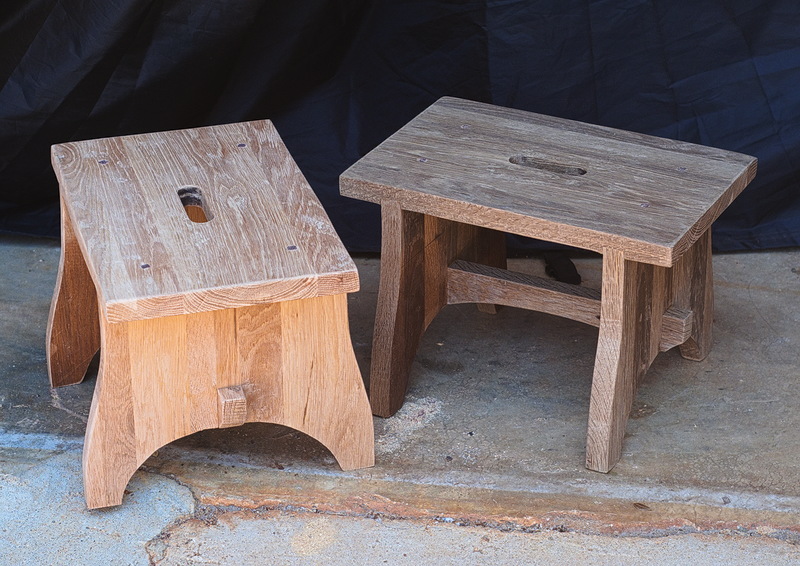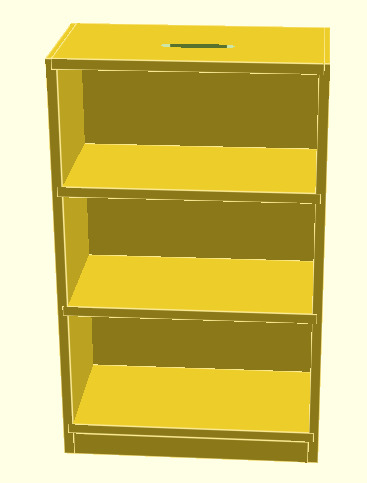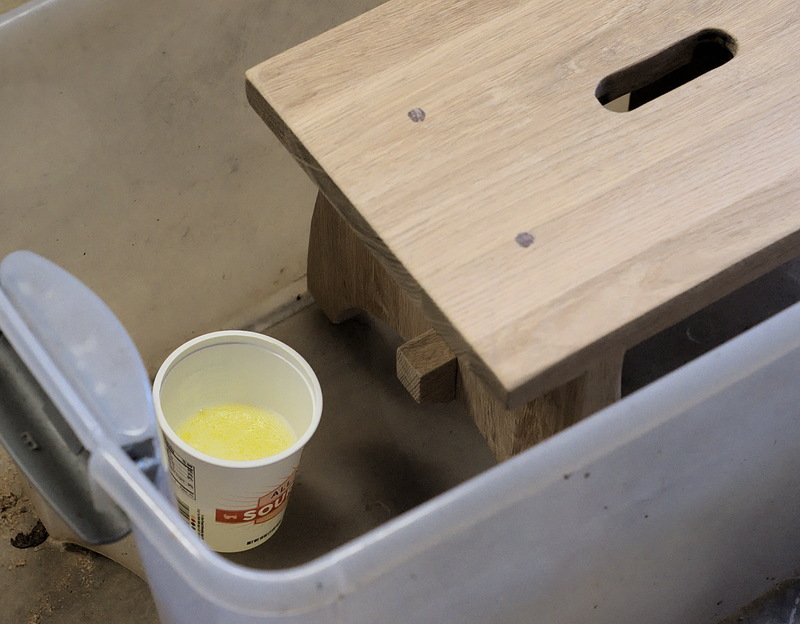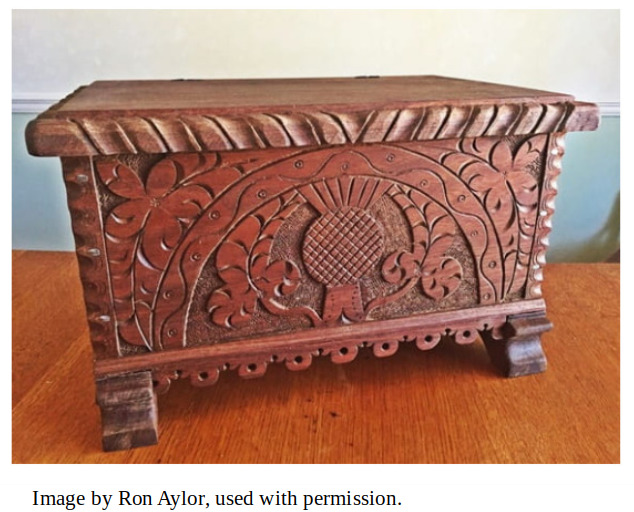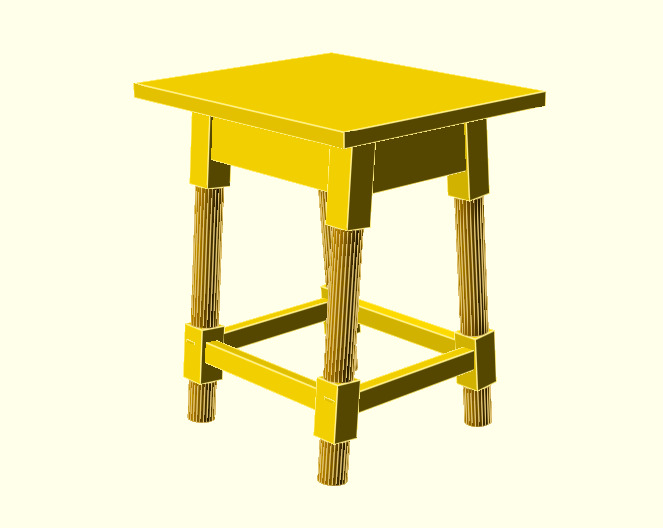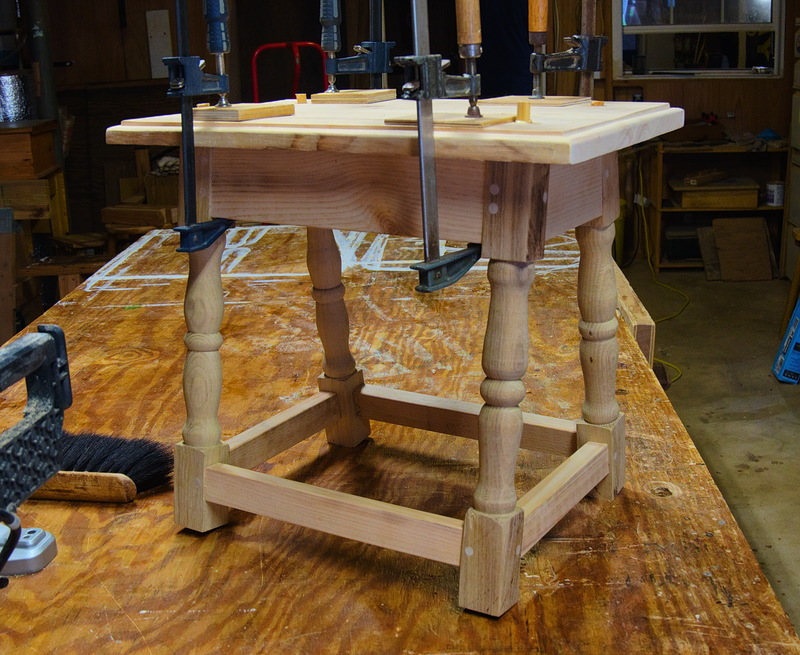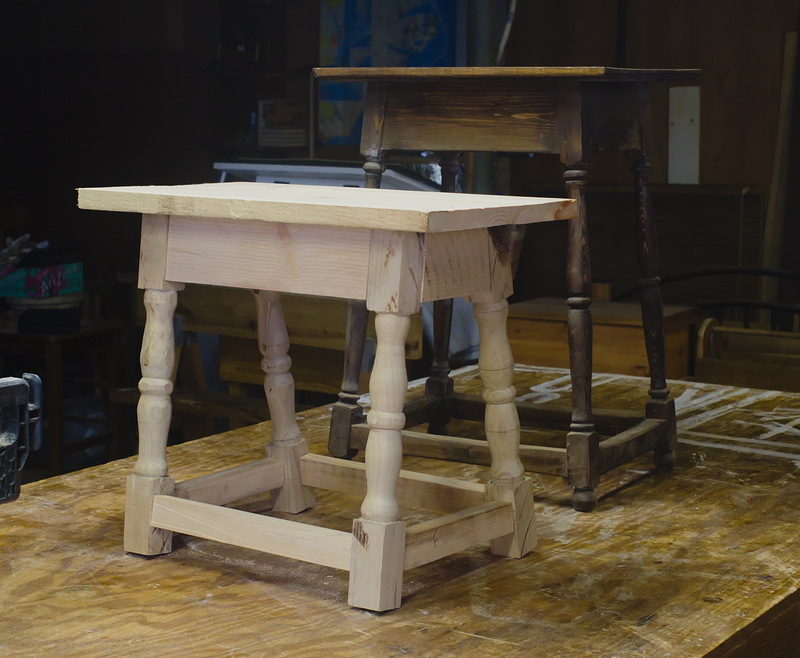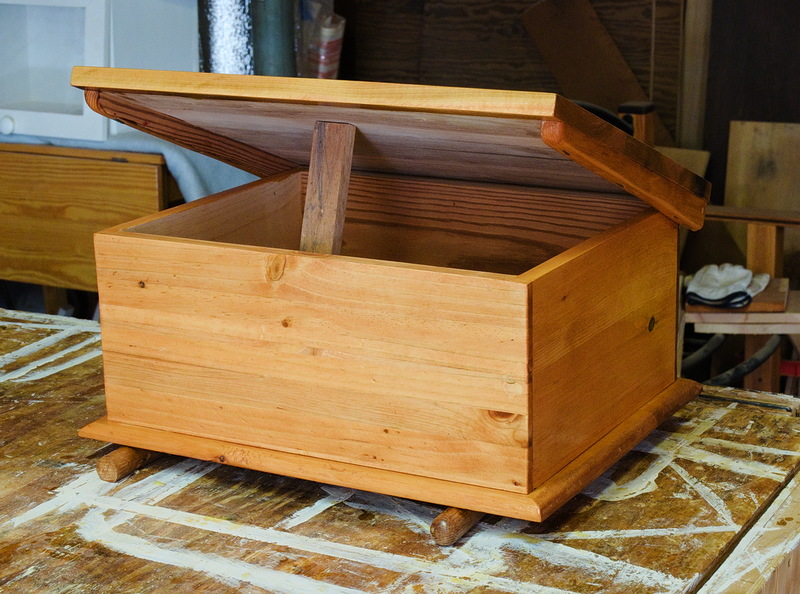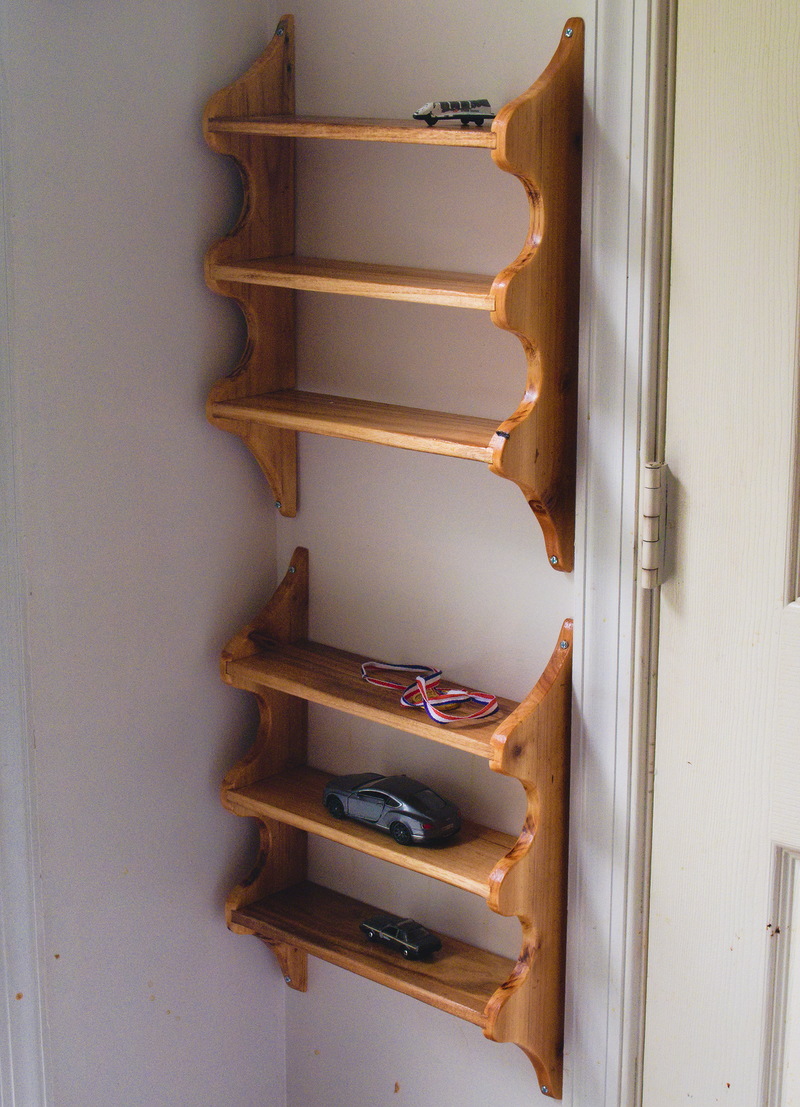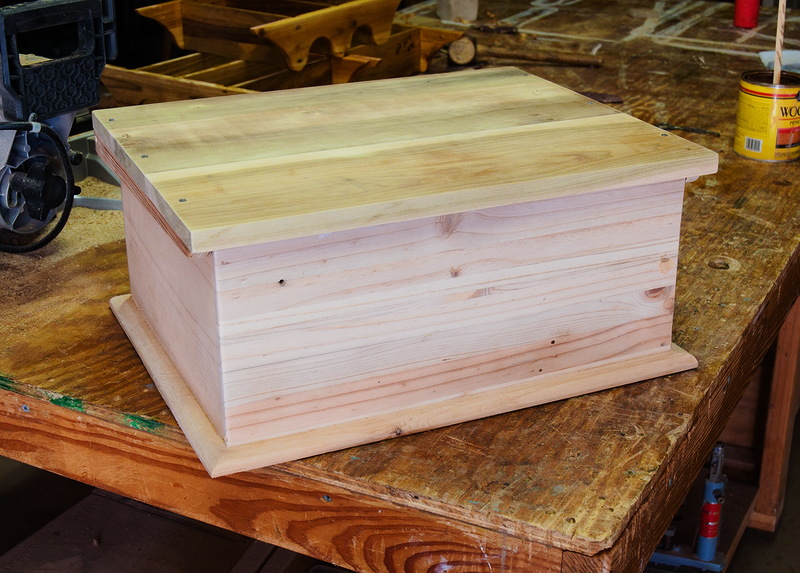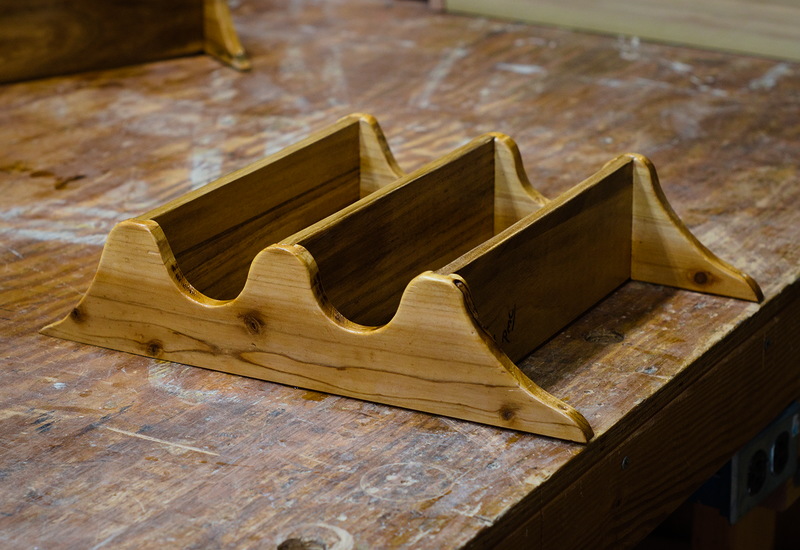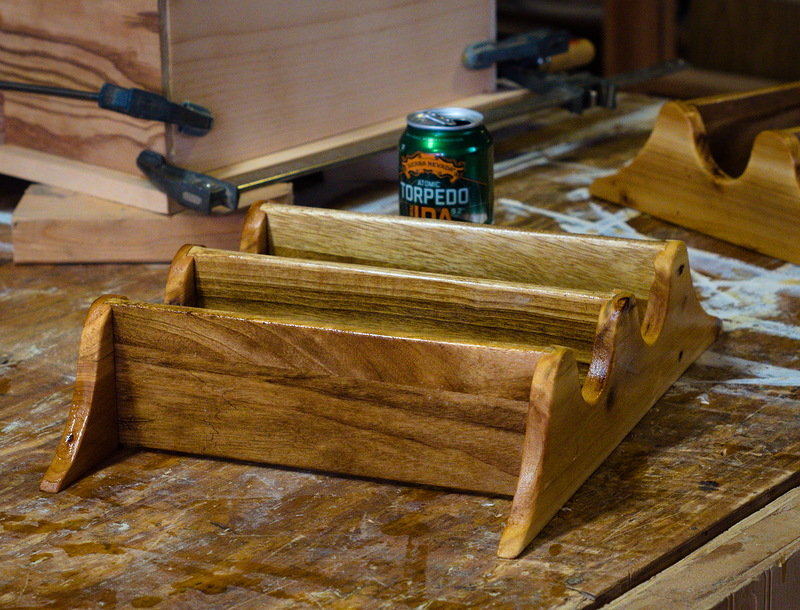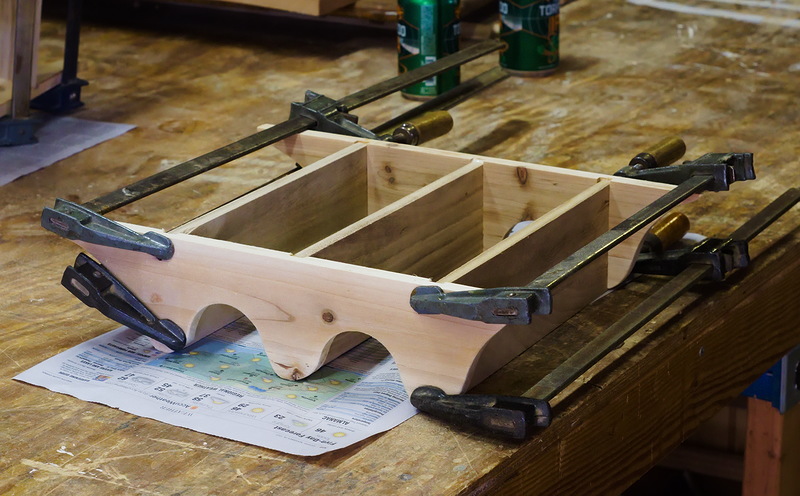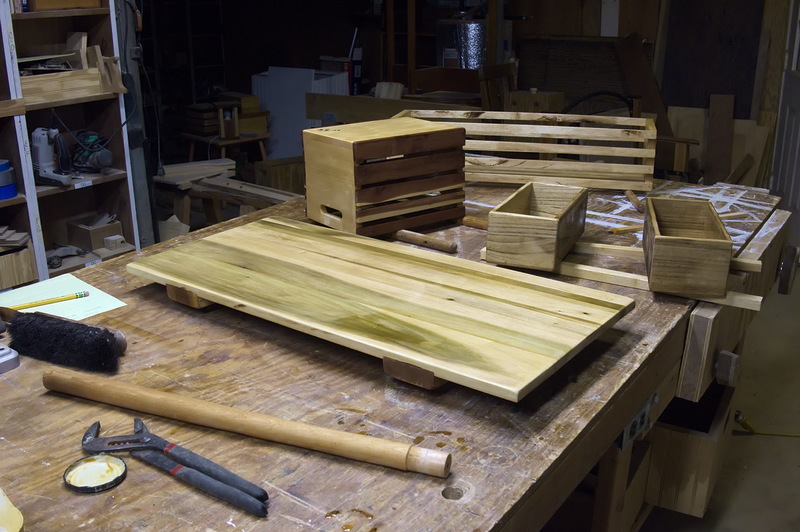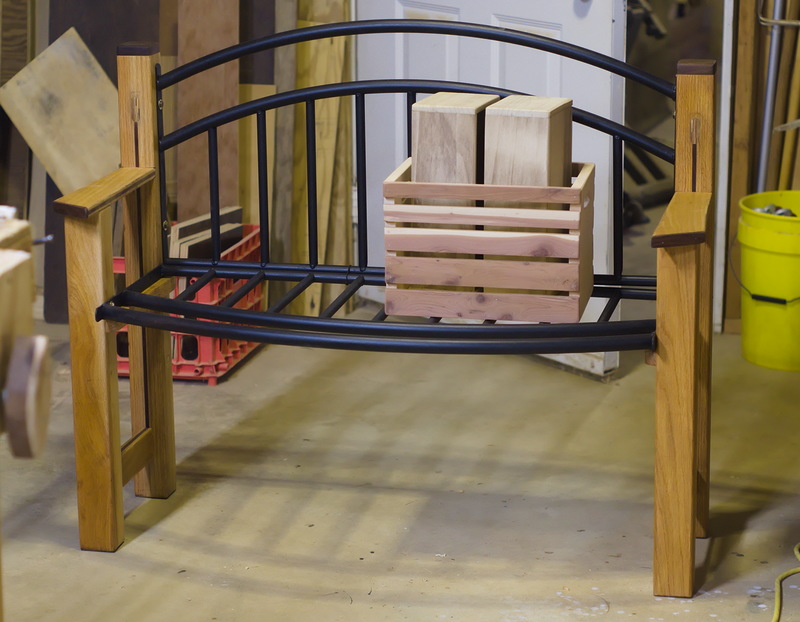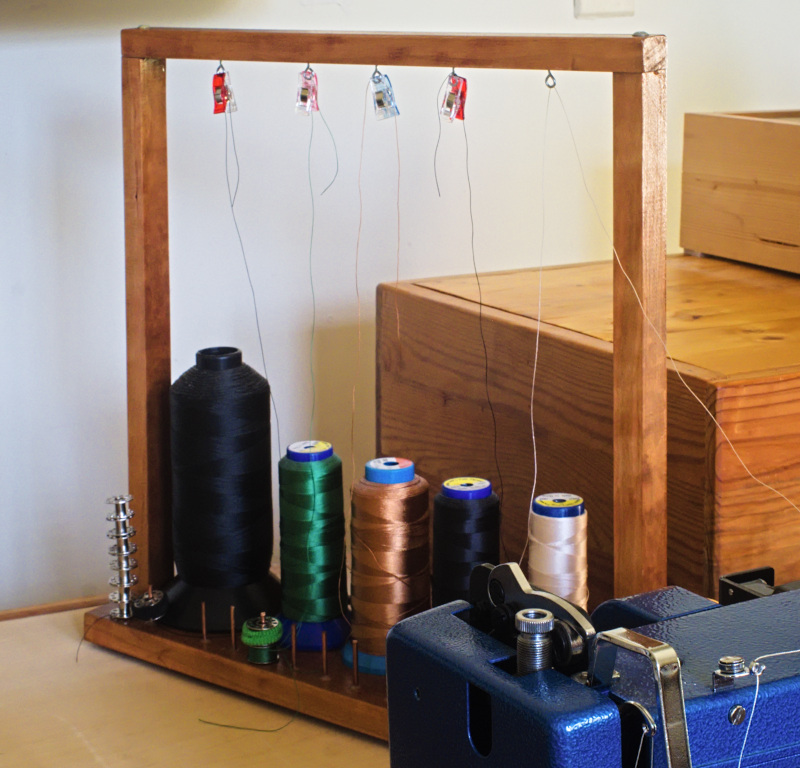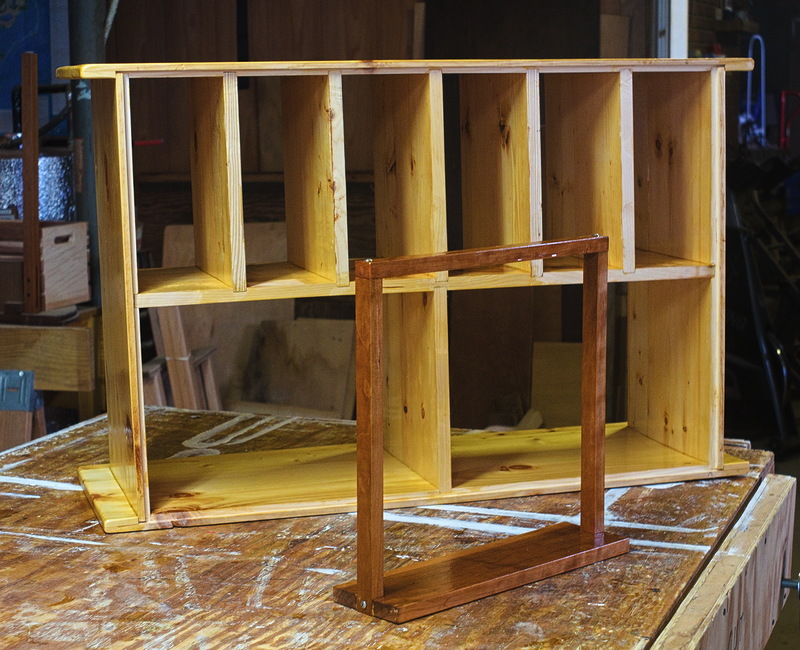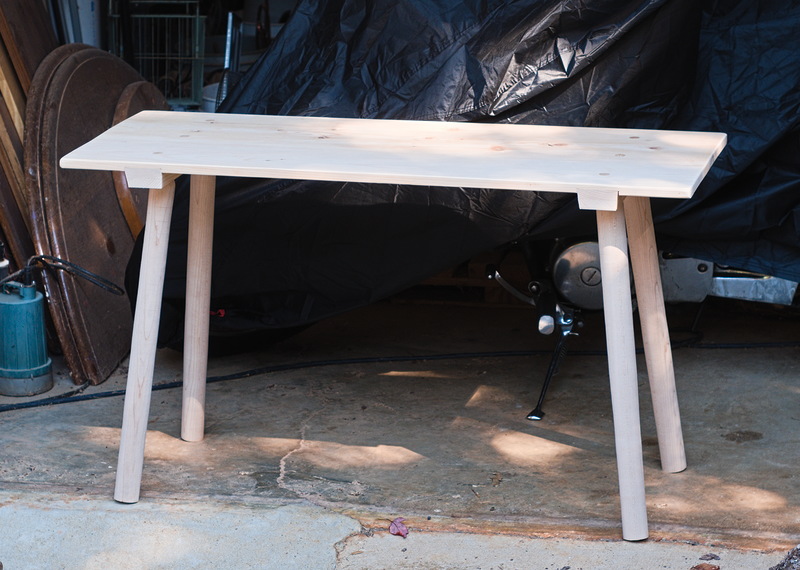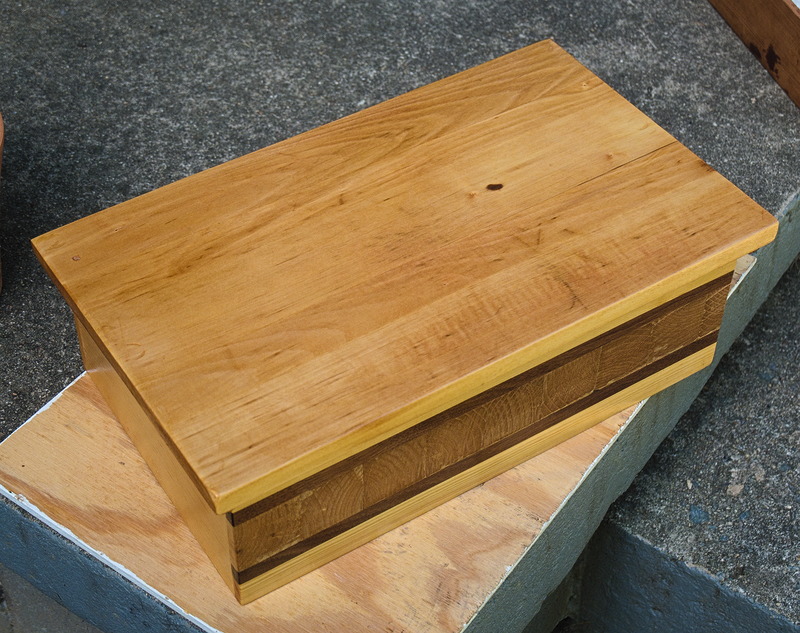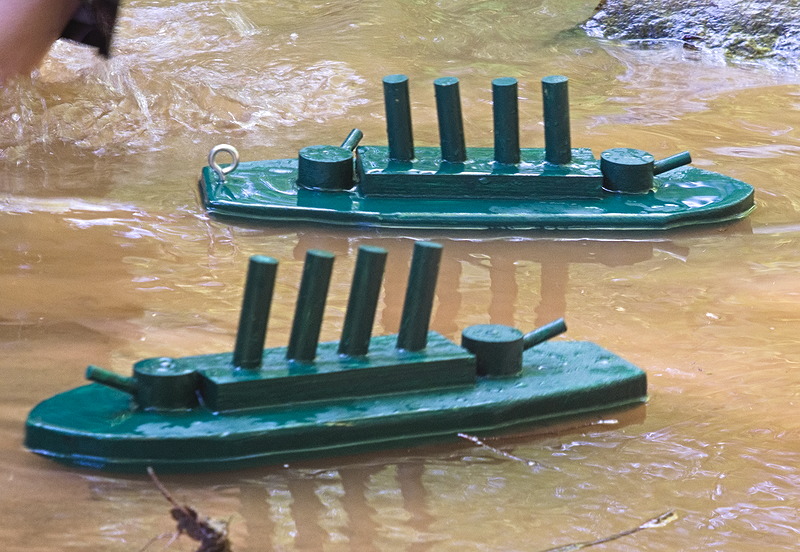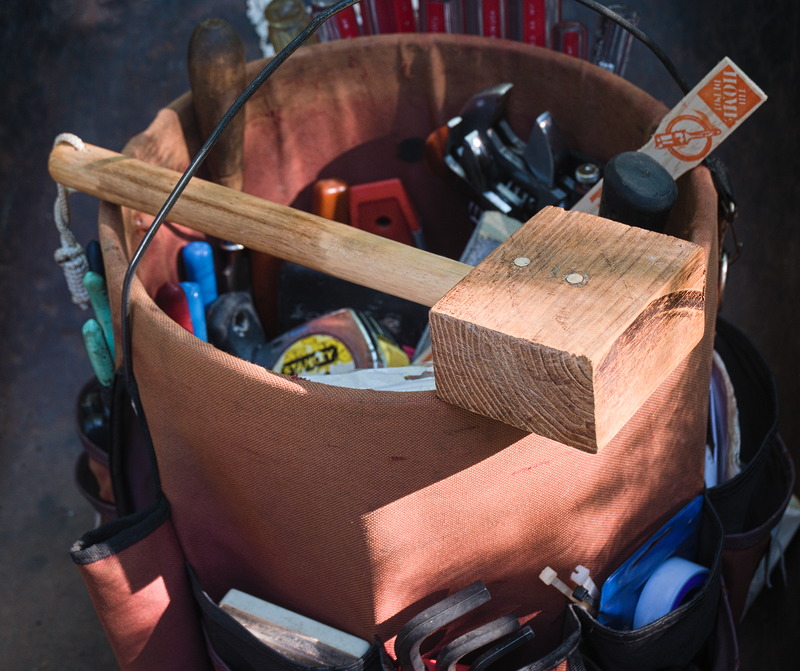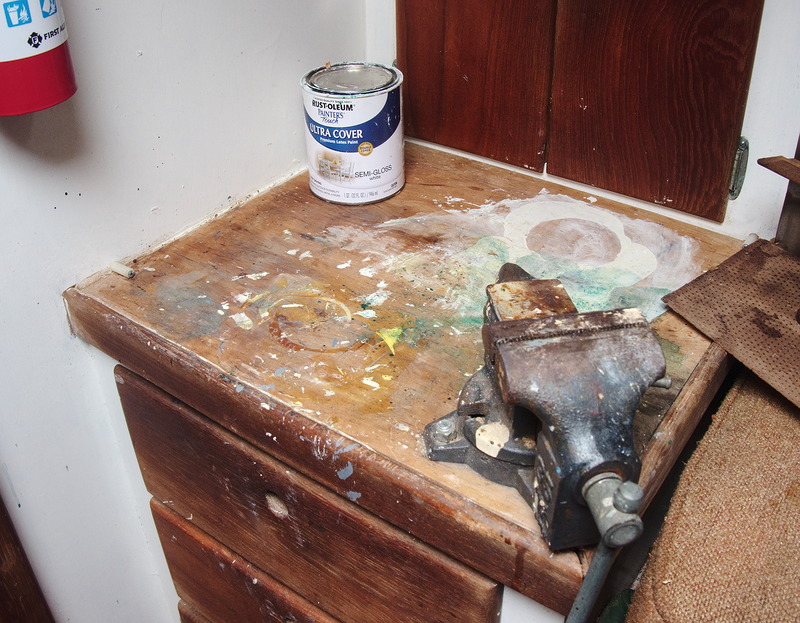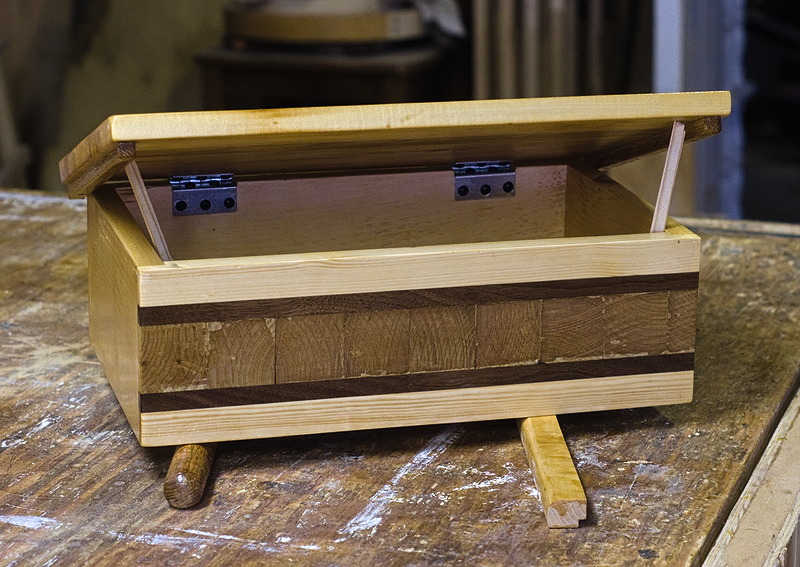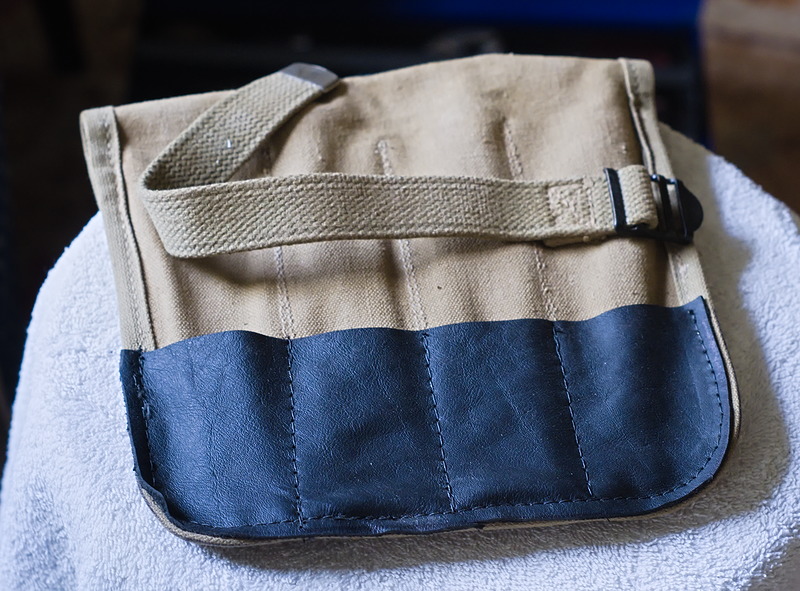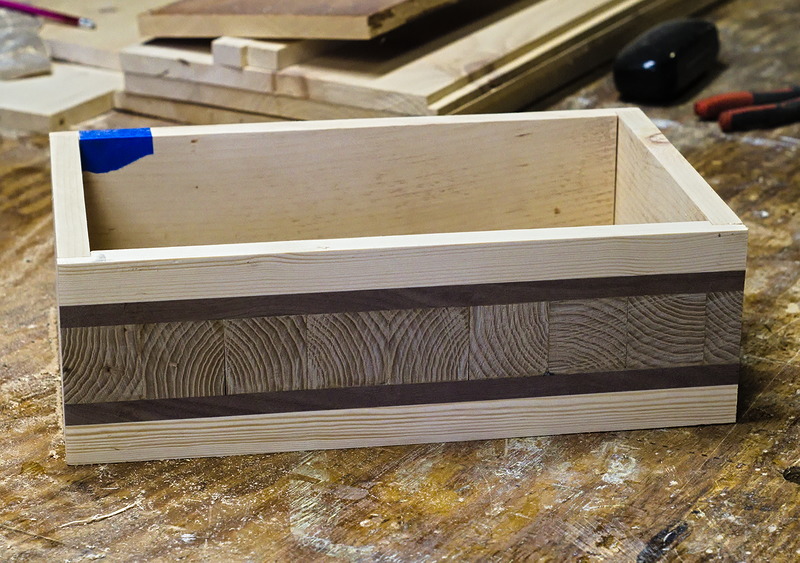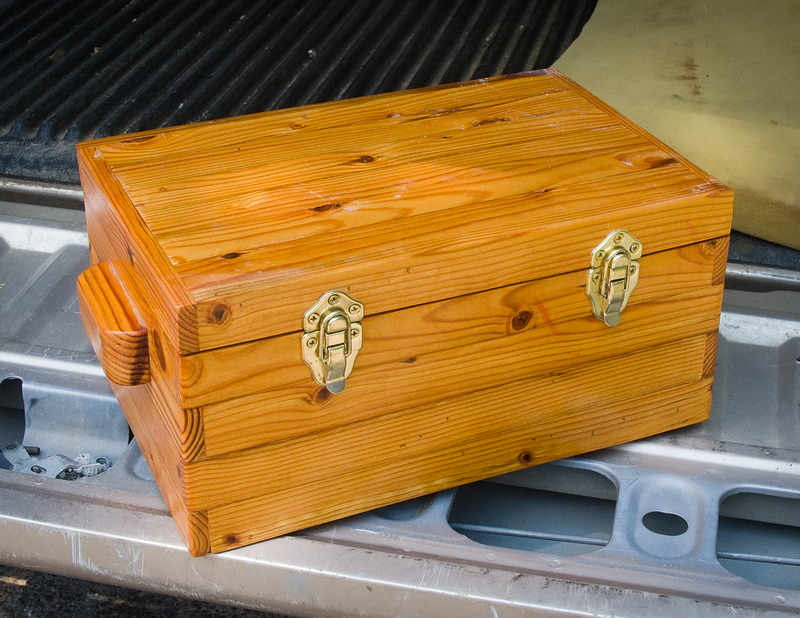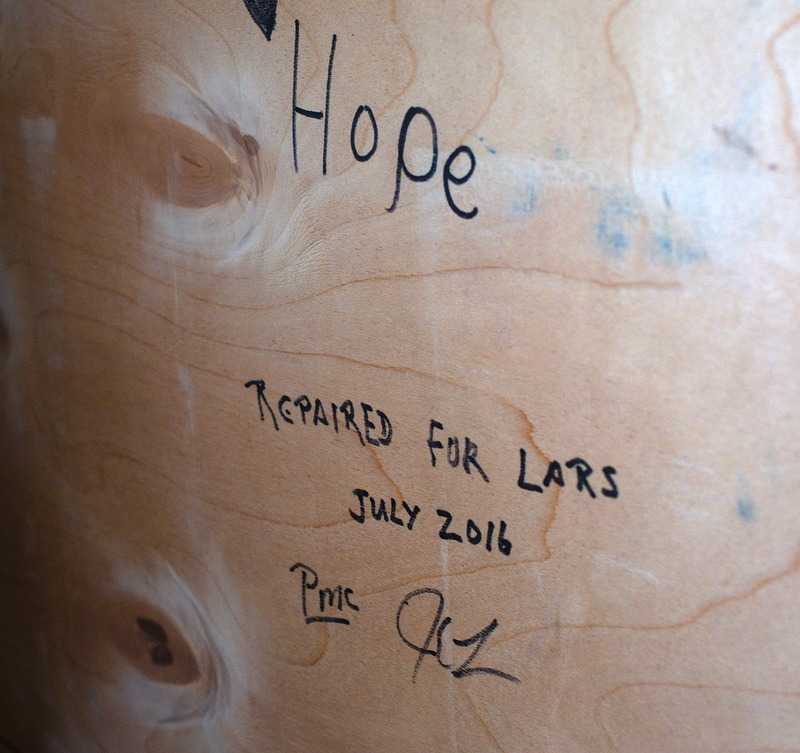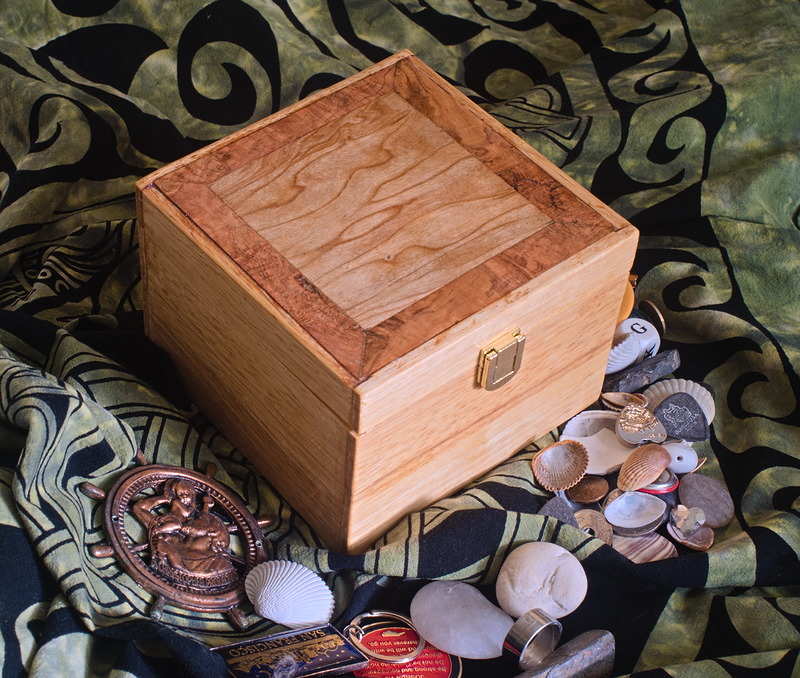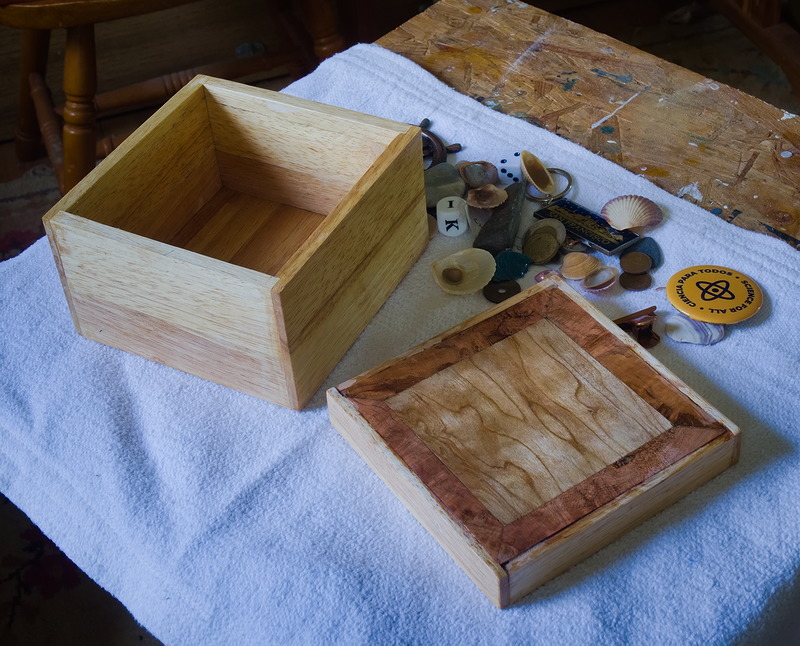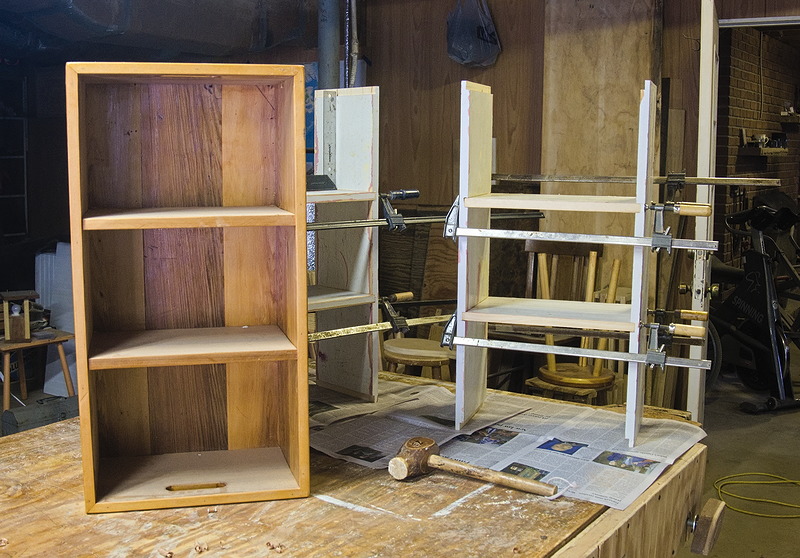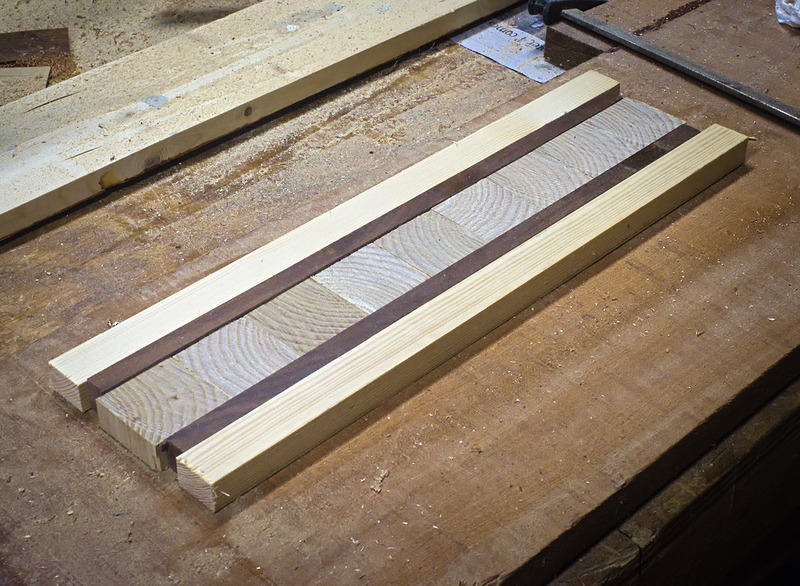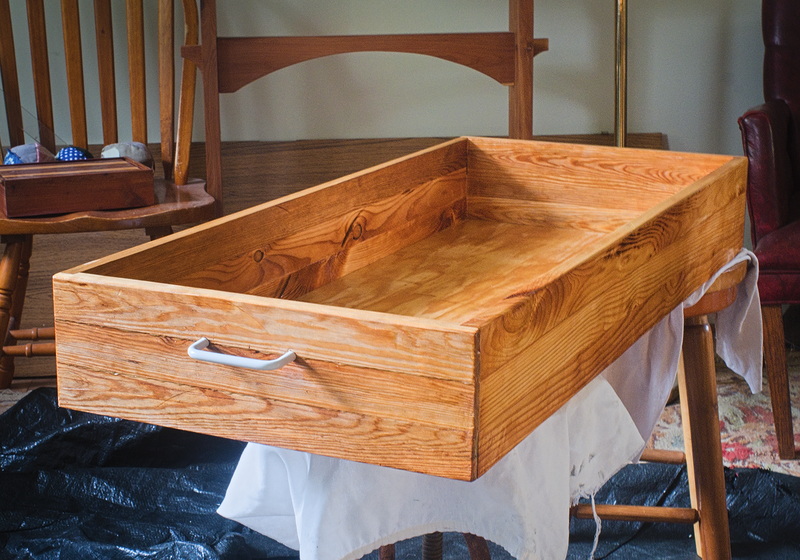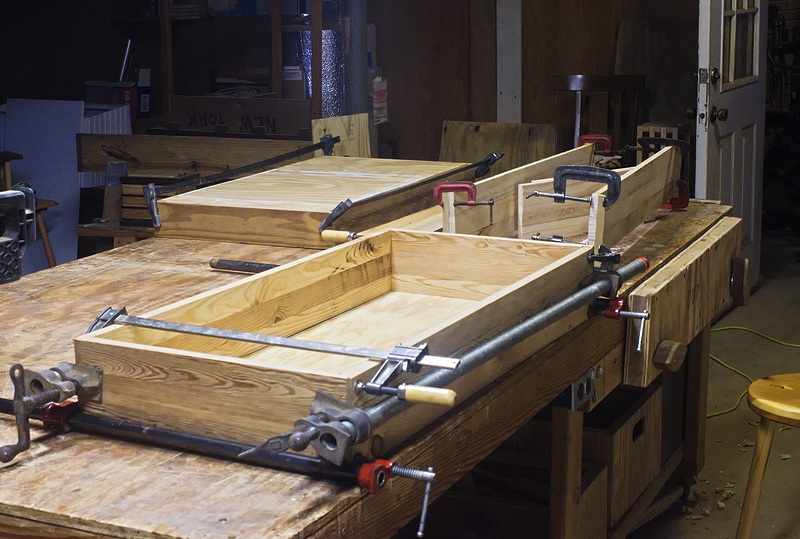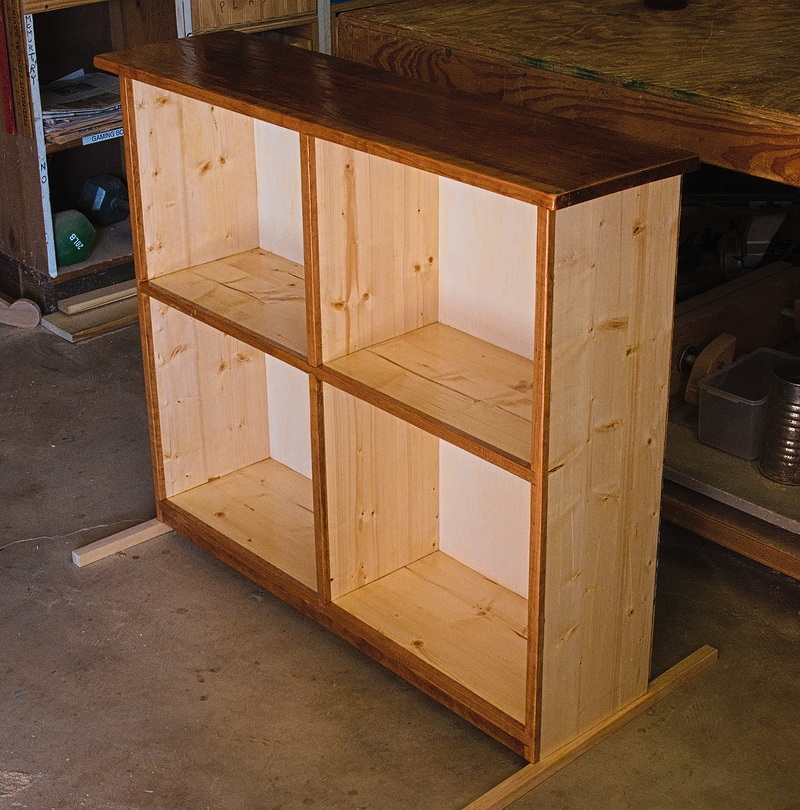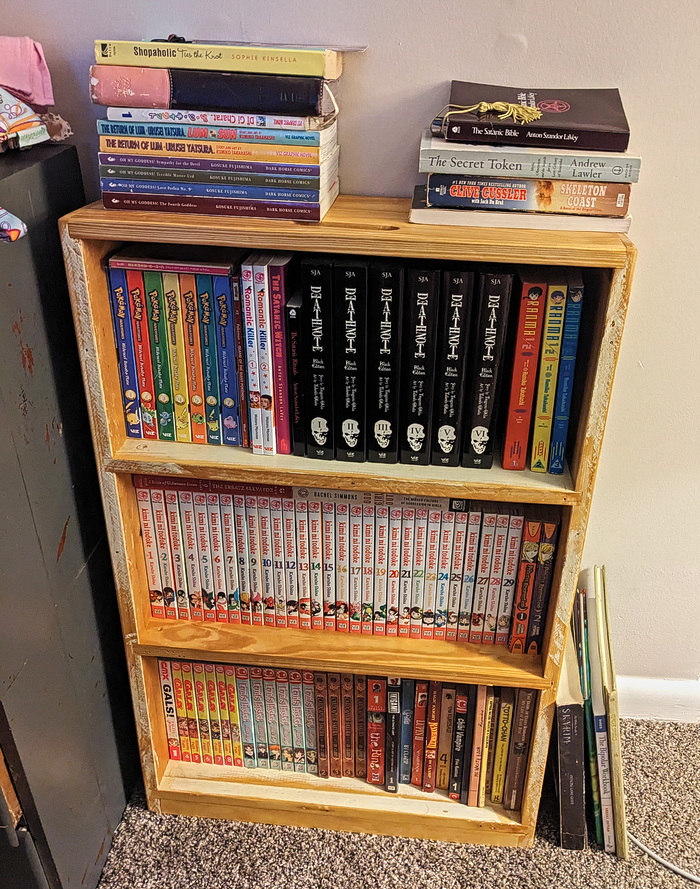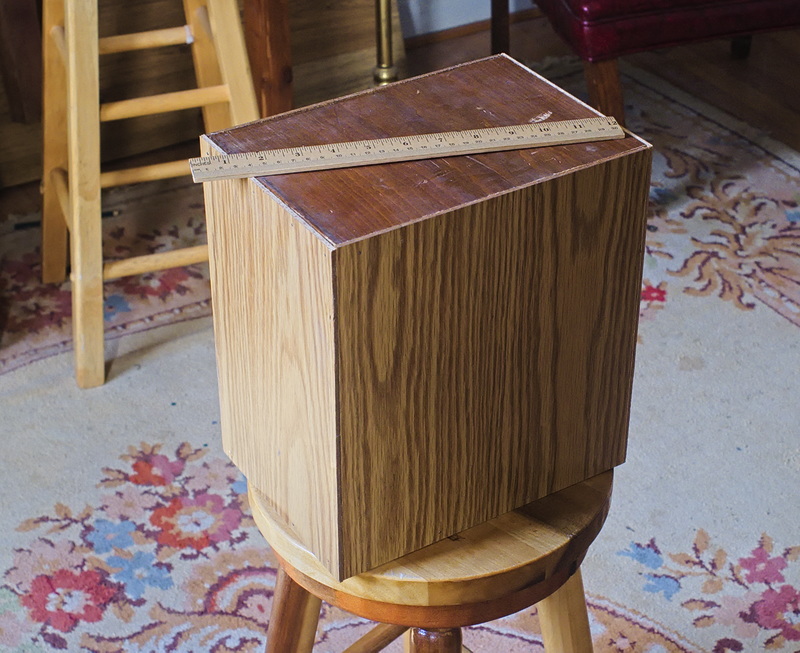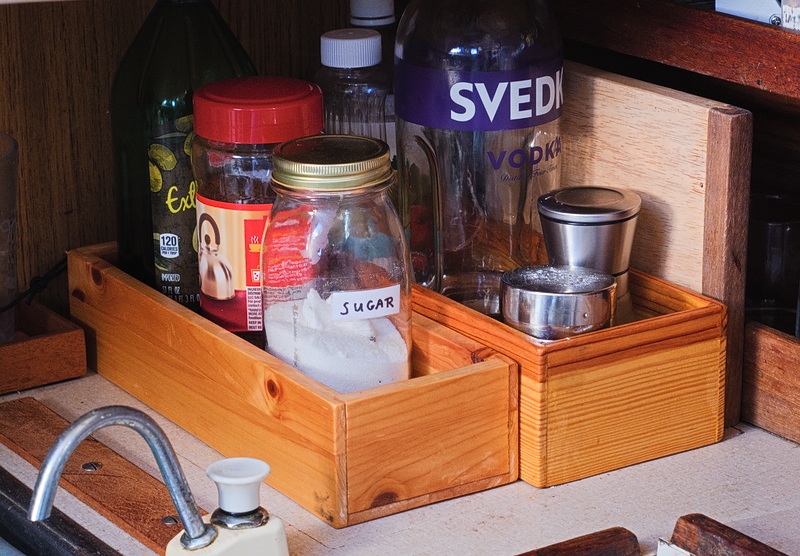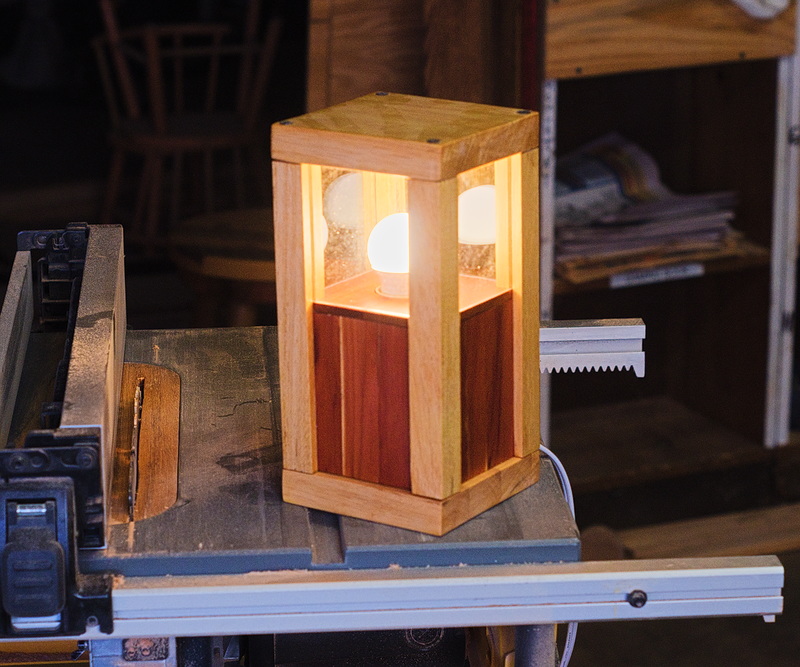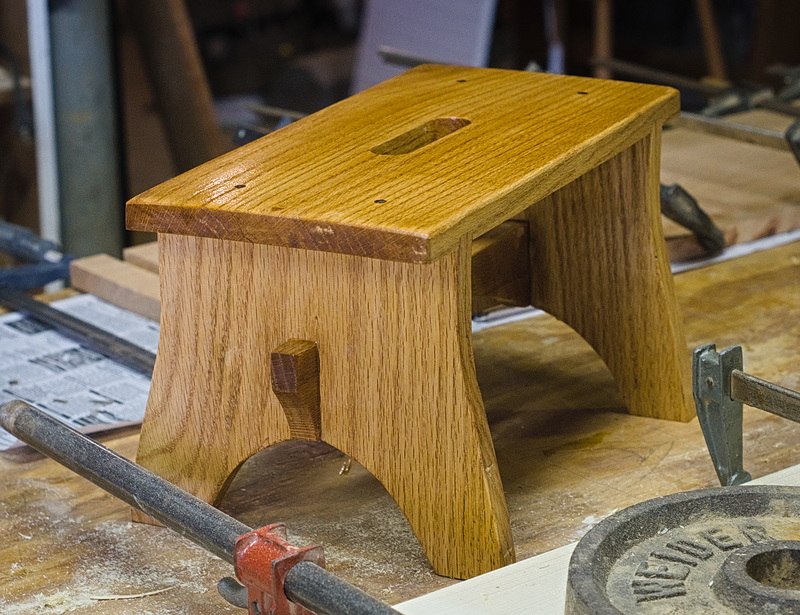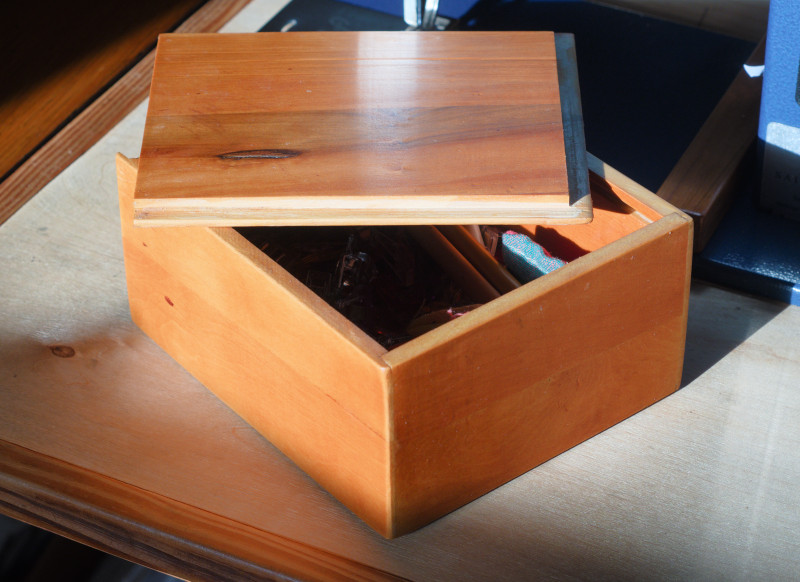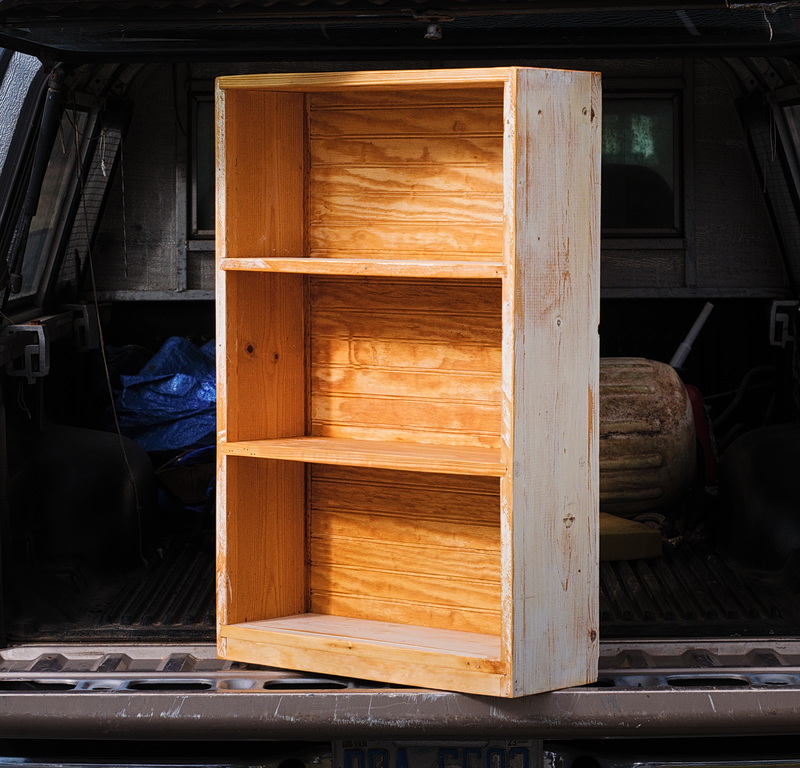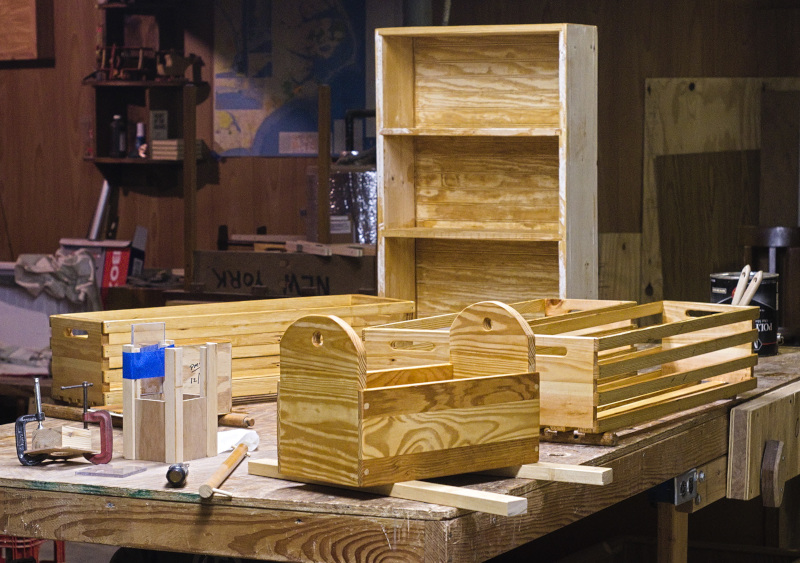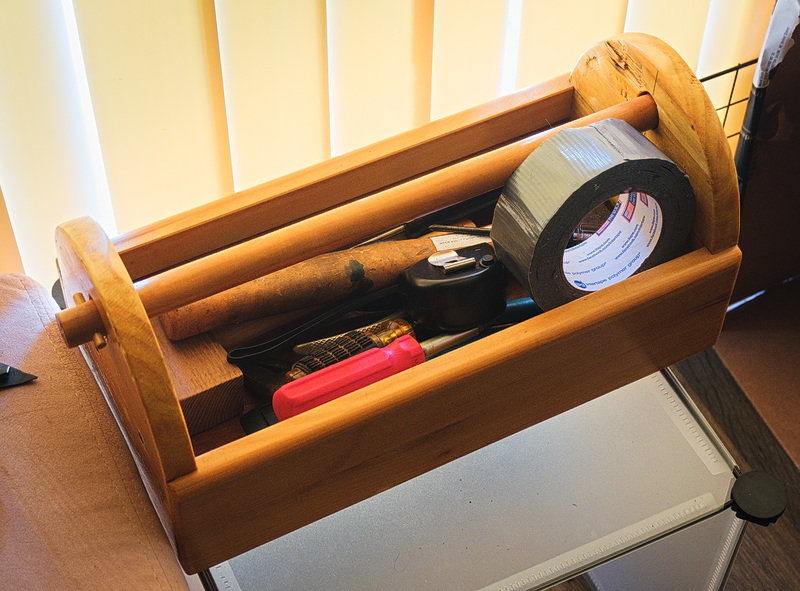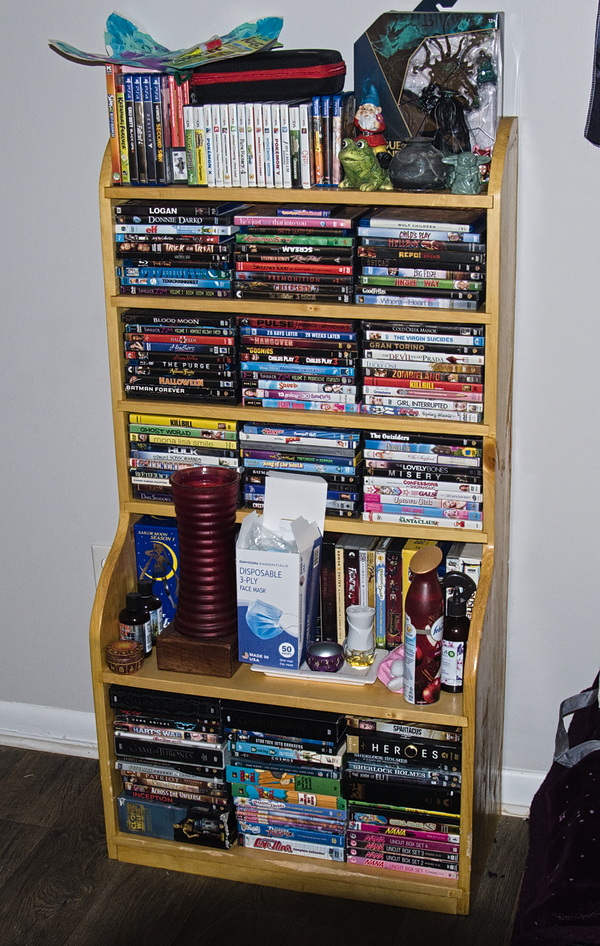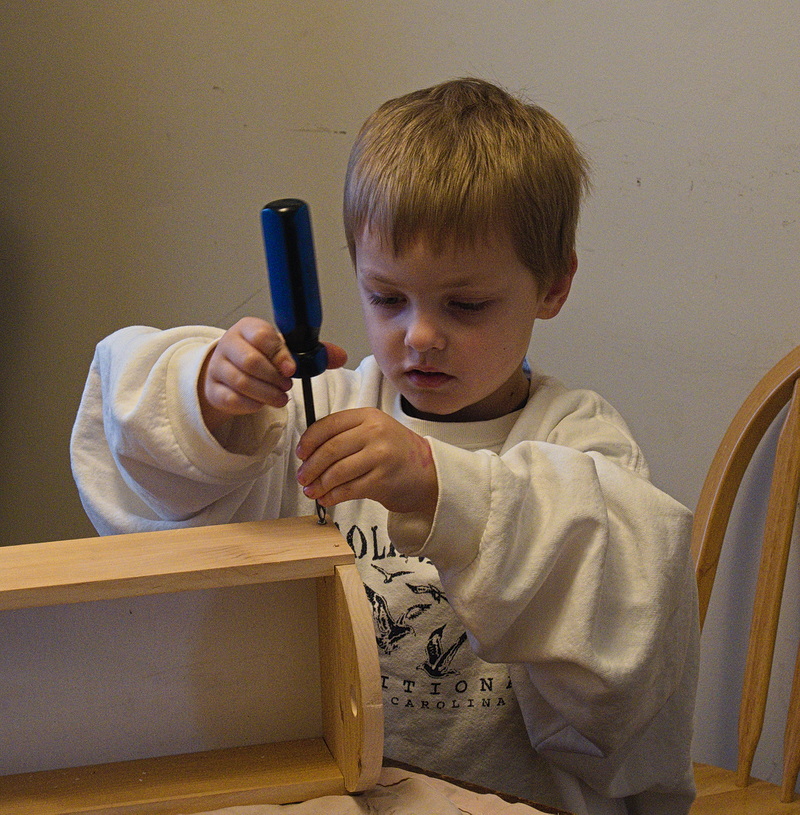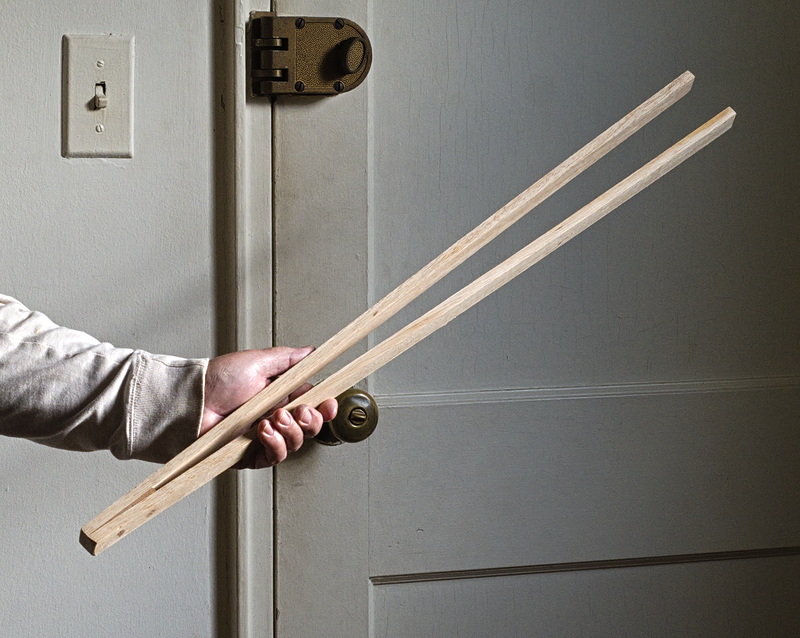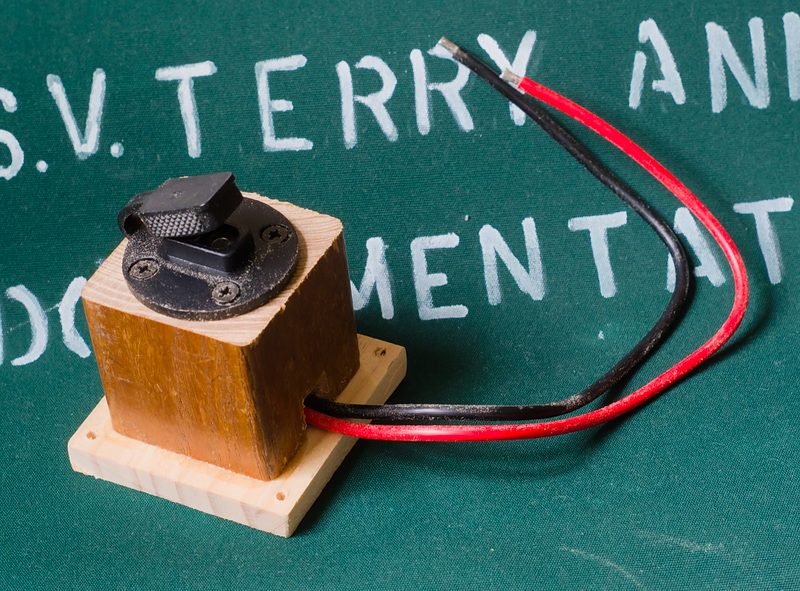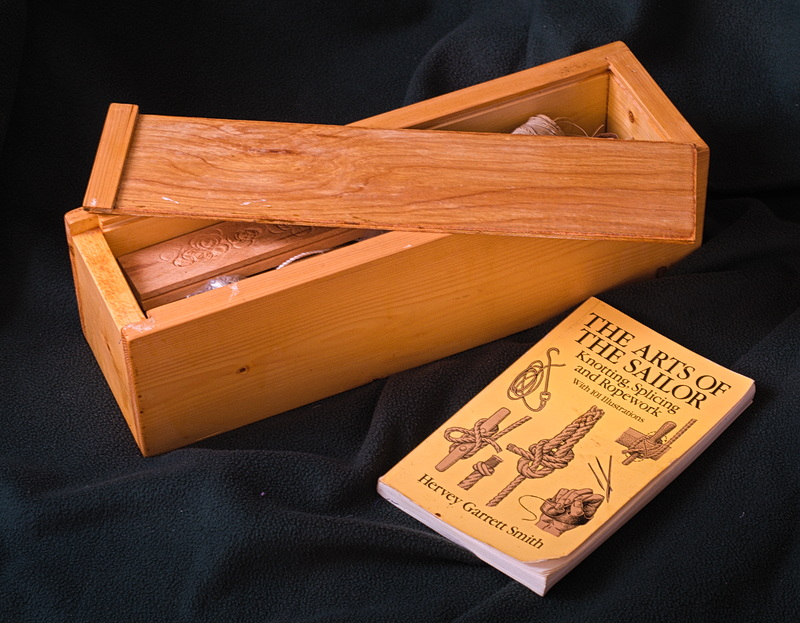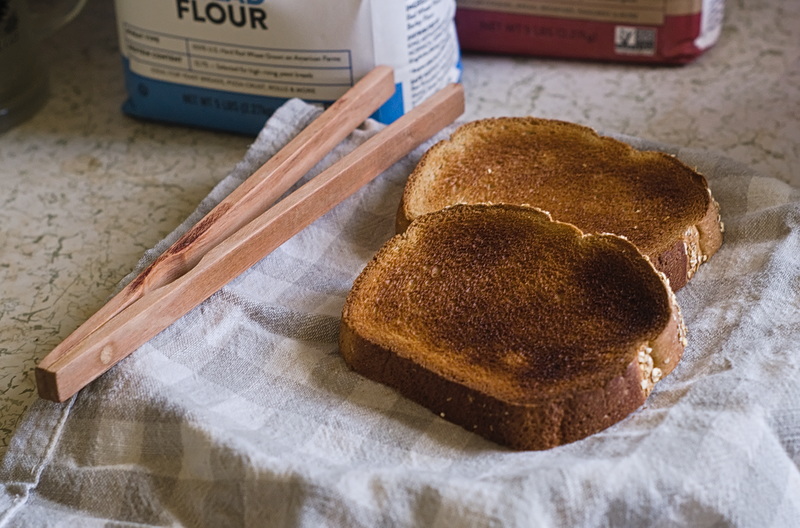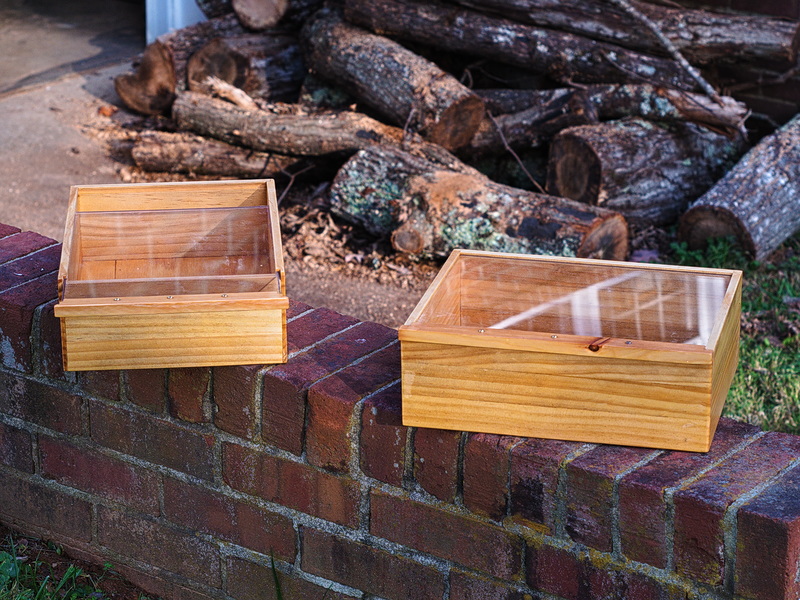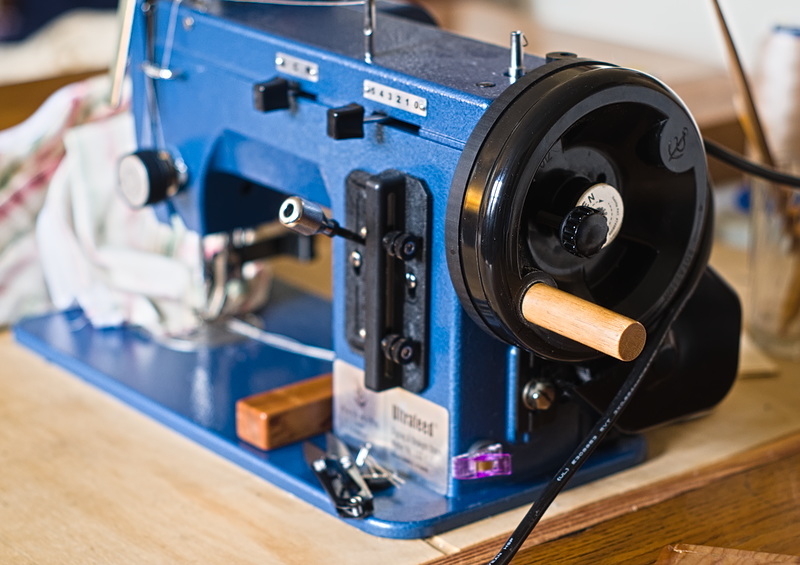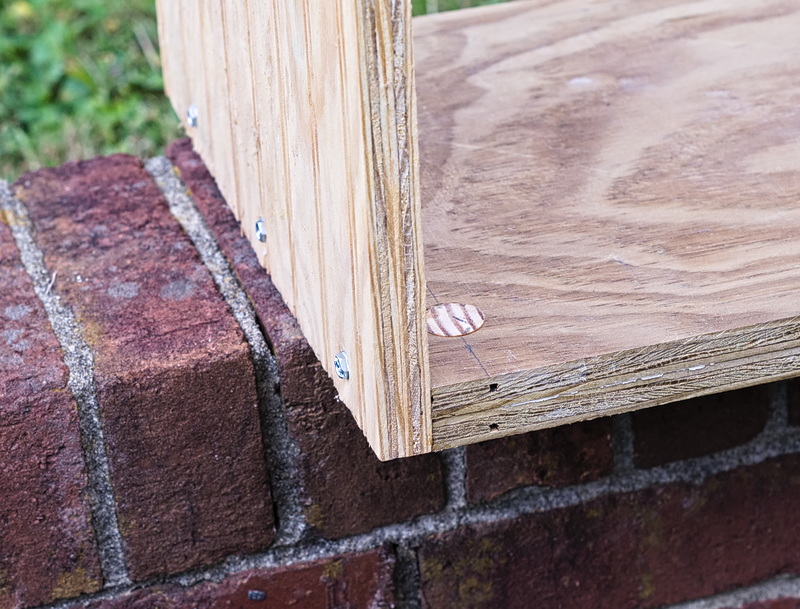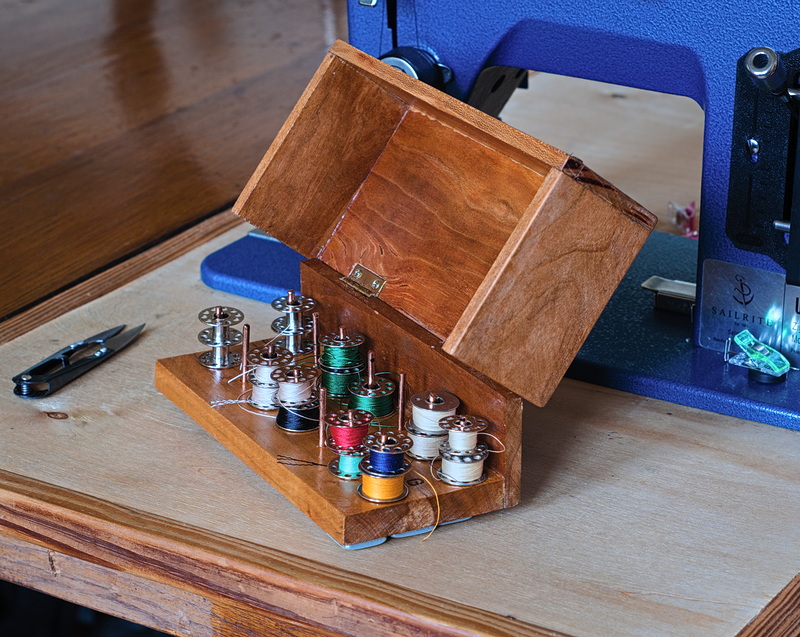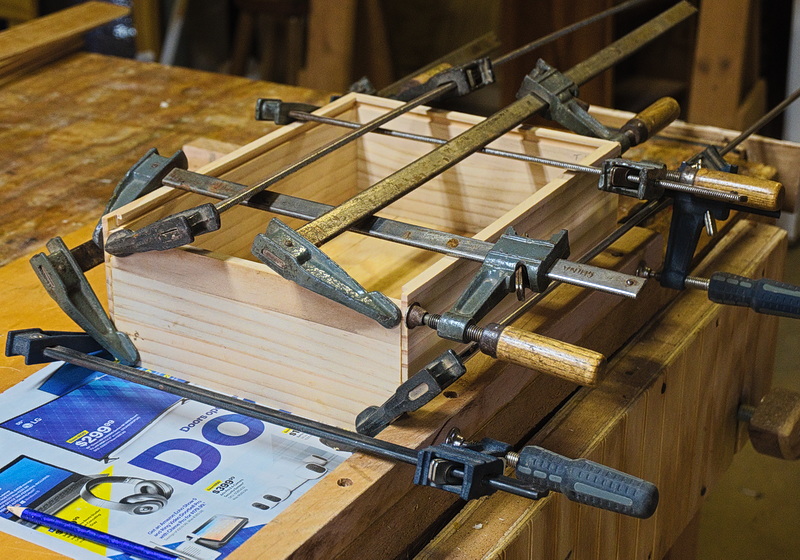July 20th, 2024
Posted by Paul
I took one of the ammonia-fumed step stools home to work on the finish and try to get a good picture. We had brushed on two coats of poly in the shop so it didn't need more buildup, just to get all the nibs and runs out. I gently sanded it and then applied two thin coats of spray polyurethane. If you get the second coat on within two hours you don't have to sand between them, but if you wait any longer you have to give it 72 hours and a sanding before recoating, so I got the second coat on promptly. Then I gave it 72 hours to thoroughly cure and lightly sanded with 1000 weight paper. After this I coated with Johnson paste wax and gave it a good buffing.
In my sunny living room, the golden-brown tones characteristic of fumed oak, so well-known from the works of Gustav Stickley, manifested themselves, making for a pretty picture.
July 12th, 2024
Posted by Paul
The second oak step-stool is done with ammonia fuming and has a first coat of poly. Joe cycled new ammonia into the fumer after three days and gave it more time, so it came out slightly darker, which we both like. We are going to try fuming samples of other wood varieties to see what effect we get. My reading suggests that fuming has the most effect with high tannin woods like oak, walnut, cherry and mahogany, and less effect with maple, birch, pine and poplar. I'm looking forward to seeing what our tests reveal. The natural effect of ammonia in the air reacting with tannins is one of the factors that gives centuries-old medieval oak furniture its dark, verging on black, color.
July 11th, 2024
Posted by Paul
A chest is a large box with a lid, a chest with drawer has a drawer below the box and a chest of drawers is all drawers and no box. Frequently a chest with drawer has fake drawer fronts on the box to make it look like a chest of drawers.
Scaled-down furniture was built, and it is not uncommon to find miniature chests with or without drawers. For example, Kettel, Plate 33, a chest with drawer and fake drawer fronts on the box. I drew up something roughly similar and we are going to build two of them. So far we have cut out and milled most of the parts for the drawers.
July 2nd, 2024
Posted by Paul
After five days of ammonia fuming, the treated step-stool, the one in the back, is noticeably darker. We both like the effect, so the other one will now get fumed.
June 29th, 2024
Posted by Paul
We've had the woodshop for over ten years now. It's been a lot of fun, we have built boxes and crates by the hundreds and larger pieces by the dozen, and learned a lot. We have confidence that we can build almost anything in wood, and if we wanted to, we could buy some expensive equipment, a few hundred feet of exotic hardwoods from Wall Lumber, and start making beautiful high-end reproductions to sell to wealthy people to pay for it all. But that's not why we started this, and it's no more attractive to us now than it was back then. Our goal is to make useful, interesting and good-looking things out of wood that we can give away.
Some young people move out of the familial home with a few nice older pieces that have been stored away in the attic, but most of them have to scrounge furniture from other people's castoffs or buy a pressboard bookcase and dresser from Walmart. We like to make them a solid wood table or inlaid box or a useful bench or step-stool just so they will start to recognize that there is something better. Levi's friends used to be astonished that he would have something as nice as the simple cedar-topped trestle table we built for him and Marie way back in the early days of the shop.
Most young people and even older people move a lot these days, so one of our principles is to make furniture that is light enough and small enough to handle without having to call in a moving crew. Even a substantial piece like my trestle table can be easily moved if it can be disassembled.
Joe got a request for a packing box from one of Marcia's grand-daughters, so he built one out of nice cypress lap siding. It can serve as a bookshelf in between moves. We developed that idea into a small bookcase with a finger slot in the top and a kickboard with a batten behind it for a grip that would look good in the house and could be tipped back and moved without even removing the books. We have built several, including this one for Marie.
I drew up a bookcase/packing box in OpenSCAD so that we would have a drawing and dimensions to work from the next time we build one. Anyone with OpenSCAD who wants the drawing can find it here. It is parameterized so you can change the major dimensions to make it fit a particular spot. Looking at the drawing makes it clear how simple this piece is to build. All stock is 3/4". The sides and top are 10" deep. The sides are 30" long and the top is 18". The sides and top all have a 1/2" deep rabbet along the back edges to accept a plywood back, so start off by ploughing the rabbet 1/2" deep and 3/8" wide on all of them and you won't have to reset the saw later. The sides have a rabbet along the top edge for the top to set into, and three dadoes, 9" down from the top, 18" down, and 1 3/4" up from the bottom, for the shelves and the bottom. The top and shelves are all 18" wide. The top is 10" deep, and the sides are 9 1/2" to allow the back to set in its rabbet. The kickboard fits between the sides and is 1 3/4" tall. There is a lip attached to the back of the kickboard to allow a good grip when the case is being used as a packing box. I would glue and screw these parts so there won't be any risk of them coming apart under a heavy load. As drawn, there is a central slot in the top, far enough back to allow plenty of wood in front of it for strength, but forward of the half-way mark to provide good balance. The slot could be replaced with two spaced more towards the sides to allow a two-handed grip. Like the kickboard, the top should be glued and screwed, and the back should be attached firmly with glue and screws or nails.
This post has explored some facets of our philosophy and technique at the woodshop. We have a few other principles, including using salvage wood whenever possible, finishing bright and not painted, and probably the most important of all - we don't cut dovetails.
June 26th, 2024
Posted by Paul
With two completed oak step-stools, we decided to try the ammonia-fuming technique that was popularized in America by Gustav Stickley, the famous early 20th century promoter of the Arts and Crafts movement. I read about Ron Aylor's use of it in his book "Art and Craft of an Unplugged Woodworker" and suggested to Joe that we fume one of the step-stools. Then we would be able to compare the two and see if we liked the result.
Joe turned up a plastic tub that looked like it would do well, with some judicious applications of duct tape to seal up the holes around the handles. The only ammonia in the house was lemon-scented, so even if the fuming doesn't darken the wood, maybe it will make it smell good. I look forward to seeing the results next week.
June 21st, 2024
Posted by Paul
Marcia and Joe's neighbor had a tree dropped which fell into their back yard and knocked down the purple marten house. Joe has been doing repairs and has it almost ready to put back up. First order of business for yesterday's work session was to attach a vinyl sheet to the roof to serve as shingling. It is white so it should reduce heat in the house. We put it on with Weldwood Contact Cement.
Next we finished off the last cuts on the ends of the two step-stools and started fitting them into the dadoes in the top. Both were very tight. The oak was slow to work. Joe eventually got the one he was working on to fit by dint of vigorous pounding with a mallet, but ran into trouble getting it back out for glueing. His solution was brutal blows to the side of the board, and unfortunately he cracked it. While he took it aside and glued it back up, I continued working on mine. By this time I had thoroughly dulled four planes trying to get the old glass-like finish off and getting it thin enough to fit with no more than moderate force, so I resorted to the orbital sander and eventually worked it down.
We took an end from the other set of parts and got it ready. At least we would be able to glue up one stool, and the other could wait until next time. I set my end into the dado and checked it with a square. It was a little out, but close enough. Nobody would ever notice. Joe's end was a little out as well. Not satisfied, he commenced to whacking it with the mallet - and cracked it. Two in one day!
The moral of this story is - you can tap on the end of an oak piece to drive it into a dado, although it is probably safer to pull it in with the clamp - but don't beat on the unsupported side. Oak, like any other wood, will split.
One thing, though, we proved the strength of our glue-ups - neither piece broke on a glue joint.
June 18th, 2024
Posted by Paul
The 17th Century and early 18th Century American vernacular - furniture of the Pilgrim era - provides the inspiration for most of the pieces that I draw. During this time, the colonists were gradually moving away from what I call "post-medieval" furniture - massive, heavy oaken items, mostly mortise and tenoned, decorated with elaborate carving that expressed spiritualism, both Pagan and Christian. The early colonists, trying to scratch out a living in a new world, dispensed with many of the decorative features and developed their own spare, utilitarian style. In time they prospered, and started adding back embellishments, hewing closer to the sophisticated European styles. But for a short hundred years, functionality took an upper hand.
Not to say that the English didn't have their own strand of simple domestic furniture. The early 20th Century collector Arthur Hayden presents two books on 17th Century English furniture, a style that is known there as "Jacobean", the first, "Chats on Old Furniture", devoted to the high culture, architectural, heavy oak carved furniture of the wealthy, the noble and the clerical, and a companion, "Chats on Cottage and Farmhouse Furniture", which will be much more familiar to the American eye.
Reading an old post at Mark Firley's unfortunately dormant The Furniture Record, I saw a reference to Ron Aylor and his An Unplugged Woodworker site. Here is what Mark had to say: "I was studying his blog in the hopes of gaining some insight as to why an intelligent and literate person might spend time reading my blog. Still a mystery." That intriguing comment demanded a click, and soon I was at Aylor's site, reading about his adventures in recreating the intricately carved, heavy, high-culture oaken furniture of 17th Century England with nary a power tool, nay, not even an electric light in his shop in a small town outside Atlanta.
Aylor has collected and organized many of his posts into a digital book entitled "Art and Craft of an Unplugged Woodworker", available at Smashwords (my choice), Barnes & Noble and maybe some other purveyors. With delivery at the speed of the internet, I was soon reading about how Aylor set up shop and started making his own distinctive style of furniture, which I see as an urbane brother by another mother to my own colonial bumpkin vernacular.
Needing a new workbench to fit the hand-tool techniques that he favors, Aylor turned his eyes to the master and constructed a Roman workbench as popularized by Chris Schwarz. His is scaled down to the point that he can actually straddle the bench and sit on it, which works well for his construction technique, centered around handsaws, chisels and drills. He makes use of a notch in the bench where he can wedge a vertical length of stock for cutting tenons or dovetails, and he uses something he describes as an appliance, "[q]uite similar to a frog or crochet and pegs on a Nicholson bench" for other stock holding. I couldn't wrap my head around this, but he also noted that with a few clamps it could serve as a "quasi-Moxon vise". I grasped that right away and decided we had to have one of them for our shop, the first but not the last inspiration I took from the book.
With the bench out of the way, now we are into the meat of the matter. Aylor states "I am enamored with 17th-century mannerist carving." 17th-century mannerism is a high-culture art form that stresses complexity and virtuosity over naturalistic presentation. Mannerist names that we might recognize include Bronzino and Tintoretto. The high priest of mannerist carving would be Grinling Gibbons, though his work stressed complexity and virtuosity AND naturalistic representation. It is my opinion that much of the mannerist carving as seen on furniture, both English and American, can be looked upon as cabalistic cyphering. In America, mannerist carving developed into a degenerate form in which the virtuosity is less evident and the presentation is much more naturalistic. To me, Aylor's carving style looks like a blend of the English and American streams.
An exuberant and enthusiastic artist wants a big canvas, and for a woodcarver that is a good-sized panelled or boarded box, so no surprise, that is what Aylor generally builds. In his book he constructs seven boxes, demonstrating how he lays out the wood for cutting, creates the tenons and mortises for the joined ones and the shoulder rabbets (which in the English tradition he calls rebates) and dadoes for the boarded ones, how he attaches the tops with snipe hinges or pintles through the cleats, and how he applies his preferred finish of boiled linseed oil and turpentine. Incidentally, he includes some good pictures of how to install snipe hinges, something I have looked for far and wide, and the next flat-topped box we build I will propose to Joe that we use this technique. Another idea that we will certainly use is a set of inside squares that can be clamped to the sides and ends of a boarded box to verify squareness and keep it from racking during glue-up.
Aylor builds a joint stool in high style, with the aprons floored to create a bin under the lid, which has wooden strap hinges to allow it to open. The stiles are square rather than the almost universal turned ones seen in America. I have read that the colonists used turned columns over square ones because, with riven green stock, turning was much easier and quicker than sawing square. The finished joint stool, with elaborate carving on the aprons, thick, heavy stiles and hinged top, looks positively medieval to my eye. Incidentally, Aylor mentions that joint stools were sometimes referred to as coffin stools, and attributes that "to an entry in Pepys’ diary (first published in 1825): '...my uncle’s corpse in a coffin standing upon two joint stools...'", but I wonder if it is actually a corrupted version of coffer stool.
A gateleg table with carving on the top, aprons and square legs looks exotic to American eyes. Aylor fumes the parts with ammonia to darken them. That's something we need to try. We have two oak step-stools ready for assembly, and we should fume one and get a comparison to its unfumed sister.
Aylor finishes off with a nice ratcheted book stand, no carving on this one, but, as he points out, is a good way to use the ever-accumulating piles of scrap around the shop. Around here, we burn it in the fireplace in the winter, but perhaps in Lilburn Georgia it never gets that cold. In truth, we build lots of slatted crates and small boxes out of scrap, we don't burn it all. And in a way, almost all our wood could be considered scrap, since most of it is roadside salvage.
And that's it. A good bibliography follows. One thing I noticed, not a whole lot of detail on how the carving is done. Maybe this is professional reticence, maybe it is just a talented person with a knack for the job who doesn't know that most of us find this kind of work extremely intimidating. On the other hand, there is plenty of information on building the actual boxes using hand tools. If you buy this book, don't be put off by the fact that it doesn't meet Lost Art Press production values. For example, the cover and title page read "Art & Craft of an An Unplugged Woodworker". I am sure Chris and his team could jerk this thing into a $50 coffee table book, but personally, I rarely buy Lost Art Press books any more, even the digital versions, they are just too dear. I'm delighted to have been able to buy and read this book, which is worth a great deal more than the modest price. It is a window into a rather arcane genre that I hardly knew existed. The reader can expect a lot of good eye candy plus more than a few worthwhile woodworking techniques - and, maybe, an introduction to a new facet of his own journey.
June 6th, 2024
Posted by Paul
Out cruising bulky item pickup, Joe found a massive five-foot diameter oak table top, a solid inch thick, and salvaged it. To start using it, we decided to make two step stools, slightly larger than my standard plan that I developed years ago (posted February 14th, 2016) to work with 1 x 12 lumber yard planks, more on the line of the one Joe built out of thick mahogany stock for Kyle (see October 1st, 2000 post). It is interesting to see the quality of the wood that commercial furniture makers had to work with in years past. This oak is dense, straight-grained and knot-free with no cup or warp, exceptionally nice wood. Of course, it is tough and hard. When Joe drilled the holes to make the finger slots in the tops, it was more like a wood-burning set than a boring tool - admittedly, the bit was very dull.
May 27th, 2024
Posted by Paul
OpenSCAD might be a good tool for drawing plans. One issue so far is that creating the profiles for turned parts looks like it might be very complicated. In this rendering, I have left the cylindrical parts plain, and they could be turned following a hand-drawn profile. Another issue is that like all 3D design programs, OpenSCAD is based on millimeters rather than inches. Converting to inches is not hard, but the output is in hundredths, whereas we are used to working in eighths and sixteenths. The advantage of using OpenSCAD is getting the good perspective views that allow a real appreciation for how the end product is going to look.
May 24th, 2024
Posted by Paul
Joe cut off the pins in the mortise and tenon joints that we set last month, and today we worked on getting the aprons and legs flat enough to install the top. After a good deal of work we got it close and tried clamping the top in place to see if the gaps would pull up. Between racking the frame and slightly bending the top, we got everything tight enough to drill the pin holes through the top and into the ends of the legs - or stiles, as they are properly called. We set the pins and put the assembly aside to dry. Next time we can trim the pins and do a little sanding, and call it done. At some point it will get a finish, but our intention is to let it age a bit first, to see if the colors darken.
April 27th, 2024
Posted by Paul
The joint stool is substantially finished, with the mortise and tenon joints glued and pegged. Remaining is to cut off the pins, level the feet and top edge of the base, and then we can pin the yellow pine top in place. After that, we will give it a little more sanding, put the completed piece in a corner somewhere and let it sit for a month or two, to see if that will allow the colors to deepen and darken. Then we will finish it with a few coats of polyurethane.
This project went together surprisingly easily. It proved that perfectly dimensioned lumber is not a requirement for building this kind of colonial, I would even say post-medieval, furniture. All measurements can be referenced off one surface and any thick or thin sections left to the back. For example, the yellow locust posts varied in dimension by an eighth of an inch or more, so the mortises were located from the front edges of the posts - one eighth setback for a shadow line, plus five sixteenths for the front of the apron, to locate the front of the mortise seven sixteenths back. Then the three eighths mortise was located and any extra depth was left to the back. Likewise, the thickness of the aprons varied a quarter inch or more, so the tenons were located five sixteenths back and made three eighths inch deep. The extra depth was left to the back. All this is exactly how colonial woodworkers handled their riven boards. Seriously, nobody sees the underside of a joint stool unless they are falling-down drunk, and then they don't notice. People have gotten used to closely dimensioned commercial lumber, power planes and joiners, CNC milling machines and such, and they are clueless as to how to handle random dimensions.
I can see how perfectly dimensioned lumber makes it possible to build the more elaborate, I would say baroque, furniture that a lot of woodworkers like, but it doesn't attract me at all. I prefer the colonial vernacular displayed in Kettel and Nutting. There is nothing wrong with the branch of woodworking focused on knowing how to run all the newest and most complex machines, but personally I would rather do handwork, with a few steps done on our rather primitive table saw, chop saw and drill press. Each to their own.
April 18th, 2024
Posted by Paul
The joint stool ("joint"- irregular past tense of "join", analogous to "burn-burnt", "dream-dreamt", "mean-meant"), is now not just a stack of parts, it is truly joined - or joint. The mortises and tenons have been cut and fitted. Now it can rest in assembled state until next time we work, when we will glue and pin it together.
In the earliest colonial days the chair, if there was one, was reserved for the patriarch and all other members of the household sat on either forms (what we know as benches) or joint stools. As the years passed, if the family prospered, they would acquire more chairs. Joint stools gradually disappeared, and of the many thousands, perhaps millions, built during the colonial era, only a few are left. They went out of style and nobody built them anymore, or even bothered to save the old ones.
The heavy structure and simple turnings of the joint stool harken back to medieval times. In those days, planks were riven and turnings were made from green wood, much easier to work with hand tools than modern sawn and kiln-dried lumber. The yellow locust legs of our stool would have been demanding to produce on a kick lathe, but on the Shoprite they were relatively quick and easy. The pine board we used for the aprons, stringers and top, on the other hand, was an ancient one cut on a circular saw and it had a lot of variation in thickness, between 3/4" and a fat inch. A power plane would have made quick work of flattening it, but we don't have one. Rather than hand-plane this much wood, we did as a colonial woodworker using riven lumber would. We established a front for each part and then referenced cuts from that. The cuts on the back fell as they might to make the tenons the right depth.
The tavern table, cousin of the joint stool, had a longer life, and many more of them survived to modern times. We built ours back in 2018 and stained it with walnut that Joe prepared from husks. It is getting blacker by the year as it sits in a truly colonial location, in front of the fireplace, where it picks up dust and soot from the fire. Most surviving colonial furniture looks completely black, unless it has been refinished or heavily cleaned. While the tavern table has the same general lines as a joint stool, only larger, the turnings are thinner and commonly more ornate, and the top is thinner. The habit then was, when entering the large tavern hall, a customer would take a chair and sit where he wanted, perhaps near the fire in the winter, or in the light of a window, and the server would bring a table - so the table shouldn't be too large or heavy.
Joint stools were built with legs unraked, raked one way or raked both ways. Ours is raked one way. The difference is clear when compared to the tavern table, which has legs raked both ways.
For anyone wanting to make a joint stool, plans are included in Kettel's The Pine Furniture of Early New England. The woodworker interested in a full-on colonial hand-tool experience can find Jennie Alexander's and Peter Follansbee's Make a Joint Stool from a Tree at Lost Art Press.
March 8th, 2024
Posted by Paul
The next project is started - a joint stool from Kettel, plate 60. The top, aprons and stretchers have been rough-cut from pine, and the oak legs are at the lathe.
March 8th, 2024
Posted by Paul
To quote from Wallace Nutting, in his "Furniture of the Pilgrim Century", "The box, otherwise called Bible box or desk box, is a small article designed to rest on a table. Undoubtedly it was sometimes used for a great Bible. But in general it was a receptacle for valuable papers or other articles too small or too important to place in a chest." Since we make so many different forms of boxes, we generally refer to this type of large, hinged-lid box that in many ways is similar to a small chest as a desk box.
Ours is approximately 16x20x8 inches. We have built some slide-top boxes this large, but most of our production is smaller. Anything larger is truly getting into the province of a small chest.
We built this box from the bottom up, with a shallow rabbet all around to locate the sides and keep everything square. I very much like the tapered battens, clenched to the lid, and wooden dowel pin hinges.
The wood is whatever we could find that was close to the right dimensions - a section of old pine board for the back, glued up panels of dimensional construction lumber for the front and sides, a large glued-up panel of poplar from a salvaged piece of furniture for the top, and a non-descript board for the bottom. With the disparate colors and grains, we stained the front, sides and top to bring the colors more in line with the old pine back and dull out the green of the poplar top. We left the inside and reverse of the top unstained. Then we applied a coat of polyurethane, as pictured. We will put another coat or two on as we have time and then probably donate it to a charity auction.
March 6th, 2024
Posted by Paul
Lars and Lex now have their shelves and have started populating them. I think they came out very well, with good proportions and beautiful grain and coloration. We were able to build three of them in one day out of salvage wood, so that adds up to quick, easy and cheap. Practically every house could fit in one or more of these and they would almost certainly be good auction sellers. I'm game for making more, adding them to our repertoire of step-stools and boxes that we build regularly.
February 15th, 2024
Posted by Paul
We stained the outside of our desk box to try to unify the disparate woods used in construction - pine, douglas fir, and poplar.
The sides and ends are set into a shallow locating rabbet all around the bottom, and the ends are rabbeted into the sides. Battens are nailed and clenched to the top. The top assembly hinges on wooden pins.
February 15th, 2024
Posted by Paul
The desk box is one of the earliest forms, dating back to Colonial days and long since superceded. It served the function of the household office, or frequently to store the family bible. In later years it was built on a stand, and eventually someone had the idea to slant the top and hinge it at the front, producing the slant-top desk. Next the area within the stand could be filled in with cabinets, and then shelves built above the desk box, soon to be enclosed by beaded-glass doors, creating the imposing high pieces seen in the offices of lawyers and accountants.
February 5th, 2024
Posted by Paul
A little sanding and the miniature shelf sets were ready for a first coat of finish. The grain came out nicely under the polyurethane. In the background is a large desk box in the clamps.
January 26th, 2024
Posted by Paul
In May 2022, when we built the set of hanging shelves based on Plate 128 from Kettel's "The Pine Furniture of Colonial New England", I said I hoped we would get a chance to build it again. Today we constructed three copies in miniature, with all dimensions reduced by half. Joe came up with a couple of techniques to make the work go quicker - keying and taping the two sides of each unit together so that work could be done on both at once, and using a hole saw to cut the major indentations of the scallops, which greatly simplified the jigsaw work. Another time-saver was finding pre-dimensioned salvage wood in inventory. Finally, cutting all the parts for three units at once saved on setting up the tools. I plan on giving Lars and Lex one each, and I am sure Joe can find someone who wants the other. For that matter, they might be good sellers at charity auctions, and as quick as they are to build, we could make more.
December 7th, 2023
Posted by Paul
There is just enough room between my refrigerator and stove that I can hang my potholders and not worry about setting them on fire. This was a quick and easy project using a scrap of cherry, some purchased pegs, and two strong magnets.
December 2nd, 2023
Posted by Paul
Payday at the shop. In the front, a table leg and a poplar table top destined for the boat. At right, two butternut open-top boxes which Joe will give as New Years Day presents (Joe and I are both foot soldiers in the War on Christmas), and to the left and behind, crates that will be donated for a burn survivors sale.
November 21st, 2023
Posted by Paul
The bench is one of Joe's side projects. He found it in decrepit condition, with rotted and deteriorated wood, and rebuilt it to like-new condition. All it needs is upholstered cushions, which I think would be a great next project for Joe now that he has discovered the joys of sewing. Also pictured are a few crates that he is getting together for an upcoming burn survivors auction.
October 29th, 2023
Posted by Paul
Here is a diaper shelf unit we built for Audrey. I drew it using dimensions from the unit advertised on Amazon that she wanted, but it seems far too big and heavy to hang on the wall. So we built a table for it to sit on.
October 25th, 2023
Posted by Paul
By the time I left the shop yesterday, the thread cone rack had dried enough for me to gingerly carry it out to the truck and on home, and by late in the evening it was dry enough to lightly sand and rub on a second coat of finish. This morning I repeated the process, and by the afternoon it was dry enough to install the pins and screw eyes. So now it is complete and in service on my sewing table. I expect if any quilters or sailmakers, both people who use a lot of thread, see this post, we may get some requests for duplicates.
October 24th, 2023
Posted by Paul
Marie's friend Audrey recently had a baby and so we built this shelf unit to hold diapers and other infant paraphernalia. We used dimensions from one that Marie pointed out at Amazon. It ended up ridiculously big for something meant to hang on the wall, so we built a table to hold it.
In front is a partially-completed rack for thread cones. It should be done in a few days.
October 20th, 2023
Posted by Paul
This staked table went together quickly and it looks good, but it has some defects that only Joe and I would ever notice.
September 9th, 2023
Posted by Paul
We're still making boxes. This one is salvage wood, hinges that our friends Rich and Sue provided, and a purchased magnetic catch.
August 23rd, 2023
Posted by Paul
Lars and Lex took their wooden battleships to the creek the other day. Joe and I built them winter 2021/2022.
August 20th, 2023
Posted by Paul
A wooden mallet is a good tool to have. We made this one a while back and gave it to our friend Mark, who has bestowed so much furniture-building wood on us over the years. Yesterday it got used tapping a length of rubrail in place on his Sunfish sailboat.
August 14th, 2023
Posted by Paul
In 2017 we built a hard maple board to fit into the top of the bureau in the forepeak of my sailboat Terry Ann. It's gotten a lot of use over the last six years as I have reconditioned the 1964 vintage Alberg 35, and there is plenty of work still to be done. The board has held up fine. Maybe I'll clean it up with a sander, not that it would improve the functionality. The forepeak is the utility section of the interior of the boat, though my crew Taylor likes to sleep on the starboard settee up there.
August 13th, 2023
Posted by Paul
A box we made using a technique that Paul Sellers uses to make picture frames - stacking end-grain sections of wood for visual interest.
July 12th, 2023
Posted by Paul
There are a couple of routers in the shop, but they don't get much use. I never had much success with them, and Joe doesn't enjoy them, even though he usually can get decent results. But today, after spending a fair amount of time wrestling with seemingly intractable issues cutting dadoes in a set of wide boards, we turned to the router and managed to get the job done. Maybe this means we will start using the routers more. With practice, I might be able to make some simple cuts with one, and Joe could learn to like the things.
July 6th, 2023
Posted by Paul
The chisel roll wore through in a corner. Joe had some thin leather available, so I took it home and patched the roll on my Sailrite machine.
July 5th, 2023
Posted by Paul
Paul Sellers demonstrated using end-grain cutoffs sandwiched between contrasting wood to make nice picture-frame stock. We adapted the technique to make the front to a box.
June 18th, 2023
Posted by Paul
The yellow pine stationery box we made for Marie in 2018 has picked up a few marks, but is still as solid as the day we built it.
May 30th, 2023
Posted by Paul
Marie asked me to repair a chest of drawers for her and help her move it into another room. The repair was simple, the bottom was coming out of one drawer and I slid it back in place and added a few brads. On moving it, I found an inscription showing Joe and I did repairs on this chest in 2016. Hope must have been in the shop that day because she signed it too. Lars would have been two years old when we repaired it, Hope would have been nine.
May 19th, 2023
Posted by Paul
The treasure box is done. It ought to help keep the boys occupied when they come for a visit. It holds marbles, shells, stones, badges, dice, coins, and other interesting things.
May 3rd, 2023
Posted by Paul
I took this little treasure box we built for Lars and Lex home for finishing and will put a couple more coats of poly on it. Then it will go back to the shop for hinges and a latch.
May 2nd, 2023
Posted by Paul
The woodshop is packed with masses of salvage wood, since it is bulky item pickup season in Winston-Salem, and Joe has scored truckloads of items from the curbside. Recently we have been experimenting with leaving remnant paint on salvage wood to get an antique look, and it worked out pretty good on a set of shelves we made for Marie in February. Last time we worked, while I planed and beveled a couple of boards for a boat project, Joe cut out some shelving boards with at least three coats of paint on them and started building a couple of his patented moving crate/bookshelves, shown here with one of the earlier ones that is still hanging around the shop. I think they are going to come out just fine.
April 27th, 2023
Posted by Paul
In a recent post, Paul Sellers showed some picture frames with end-grain blocks sandwiched between strips of contrasting wood. We decided we could do that, and it might make a nice front to a box. Ours has outer strips of light wood, probably Douglas Fir, then narrow strips of walnut, and end-grain cutoffs of oak.
April 22nd, 2023
Posted by Paul
An under-bed storage tray for Marie. The ones Joe built for Marcia and himself are already pressed into use. It's almost a shame to push this nicely-figured yellow pine tray, built from salvage wood, under a bed, but on the other hand, there's plenty more where it came from. People aren't going to quit throwing out furniture, and Joe is not going to quit picking it up. We have plenty more to build things that will be on display.
April 7th, 2023
Posted by Paul
Something new, under-bed storage boxes. Marie asked for one, and Joe liked the idea so decided to make a couple for Marcia and himself. We worked out the dimensions and designs ourselves. If you see something like this at Lost Art Press, remember, we did it first. Eat your heart out, Chris Schwarz!
March 22nd, 2023
Posted by Paul
Here's something we built for Lars and Lex. Shelving board case, cherry top and facings, painted plywood back. This uses up all but a few scraps of the 200 board feet of cherry we bought to build the kitchen hutch for Levi and Marie in 2020.
February 10th, 2023
Posted by Paul
Making simple things out of wood has gotten so routine that it has changed the way I go about all kinds of projects. I am working on rebuilding the battery bank on my sailboat, and am realizing just how much bigger the deep cycle GC2 case 6 volt batteries I want to use are than the Group 24 batteries that I am replacing. Measurements are good, but this wooden model built to the actual cube of a Trojan T105, including the terminals, will be the best way of verifying that the planned batteries will fit. Joe and I made it in less than an hour.
February 8th, 2023
Posted by Paul
When we built the first of these trays, designed to hold three half gallon bottles of rum and vodka, Joe christened it "the liquor cabinet". I found enough room in front of it to fit in a second, slightly smaller tray which could be called "son of liquor cabinet", currently holding kitchen sundries, though fifths would fit nicely. When I took this picture, the liquor cabinet was woefully short of liquor, but I do have a handle of Gosling Black Seal earmarked for the boat which will help a lot.
February 4th, 2023
Posted by Paul
I found some fixtures on Amazon and drew up plans for this lamp. We cut out parts for two and each built one. Joe's turned out better, so this picture is of his.
January 20th, 2023
Posted by Paul
A small step-stool out of some oak scraps that were laying around the shop.
January 13, 2023
Posted by Paul
Another small box. I took it home to hold sewing supplies. It replaces a blue plastic mushroom carton. Part of my campaign to rid the house of plastic.
January 13th, 2023
Posted by Paul
This one is from salvage wood that has laid around the shop for too long to remember where it came from. We decided to leave the remnant paint on, to give it an antique look.
January 3rd, 2023
Posted by Paul
Last work session we applied finish to a massive table full of projects. In the back, a moving crate/bookshelf. We built this out of salvage wood, and just to see how it came out, left the existing whitewash on, rather than planing or sanding it clean. In front, three big DVD cases that Joe built over the preceding week - each will hold, I believe, 57 DVDs. Some member of the household suggested they could be hung vertically on the wall, a great idea that would save space in a small apartment. Also, a large tool tote that Joe built for himself - despite us building who knows, maybe 50 of these things, he found that he didn't have one himself, and needing to be able to take a selection of tools to wherever work was to be done, made his own. There is also a small box hidden behind the in-process work, that I will use to hold sewing clips and weights.
December 20th, 2022
Posted by Paul
I spotted this toolbox at Marie and Bobby's apartment recently. We made it for them back in June and stocked it with tools. Since then it has acquired a vital roll of duct tape.
December 19th, 2022
Posted by Paul
Last March we built a bookcase for Marie's DVDs. She has put it to good use.
To build it, we bought shelving boards from Home Depot. Lumber prices were high at the time, but shelving boards are about the cheapest thing you can get, outside of salvage. I doubt if this piece has more than $50 worth of materials in it, and as far as I am concerned, its quality and appearance are superior to anything Marie could have bought at retail even for twice that price. So this goes back to one of our initial premises of having the woodshop, to make solid, attractive furniture for young people who otherwise would have to settle for pressboard or worse, plastic.
December 18th, 2022
Posted by Paul
We kitted tool totes for Lars and Lex, figuring Lars would enjoy the gluing and screwing and driving pins home, and if it was too hard for Lex, Lars could do his. That turned out completely backwards, as Lars had no interest in putting together a tote, but Lex eagerly spread glue, drove screws and pounded pins. Finishing the first screw gave him a real sense of accomplishment.
December 13th, 2022
Posted by Paul
Making kitchen tongs, Joe said he wanted to make a really long set, but he couldn't think of a use. I suggested that young fathers might find one useful when learning to change diapers, but we decided to pass on it for the time.
The next week, aboard my Alberg 35 Terry Ann, while draped over the engine, head down, trying to reach the transmission case oil drain plug, I dropped a puck light, which slide down under the motor mounts and into the bilge. I could see it shining down there. but the boat has a deep bilge and there was no way to reach it. At the hardware store, I found a "reacher grabber tool", but they wanted $25 for it, far more than the puck light was worth. The other hardware store had the same tool, but they wanted $27 for it. The clerk did have an idea, though. He said I should flood the bilge with a hose until the puck light floated into reaching distance. That sounded like more trouble than it was worth.
I figured I could get a "reacher grabber tool" from Amazon for a lot less than $25, and filed that idea for when I got home and put together my next order. On second thought, I realized this was the perfect use for a really long set of tongs, and that the puck light probably wouldn't be the last non-ferrous thing to slide into the bilge. (I have a strong magnet on a lanyard for retrieving tools and such.)
Our custom extra-long tong set may prove to be an essential tool for deep-drafted boats like Terry Ann.
December 10th, 2022
Posted by Paul
Not having a project going on means we have plenty of time for small utility jobs like the tongs we worked on last month or more slide-top boxes. Yesterday we made a fixture for an SAE connector that I can install in the galley on my boat so I can plug in a fan or a light. I prefer this type of connector over cigarette-lighter sockets.
November 20th, 2022
Posted by Paul
Back in 2017 when we built this box to hold my rope and canvas-working tools and supplies, Joe was interested in why I would want such a long, narrow one. The reasons were, the length would accommodate my Swedish fids, used in splicing double-braided rope, and the narrowness would allow it to fit on a shelf over the starboard settee on my boat.
I went into the box earlier today to get needle and twine to whip the ends of a dockline.
November 7th, 2022
Posted by Paul
Marcia and Joe were driving on the Parkway when they passed a store selling crafts, and saw some wooden tongs at an exorbitant price. Joe decided we could make these things in the shop and that they might be good items for the Firefighters' auctions, if they ever start having them again. He explained to me that they were used for extracting bent toast that had gotten jammed inside the toaster, without burning your fingers. I was a little sceptical, sounded like the solution to a kind of middle-class American type problem, but I don't have a toaster. For all I know this is a pressing issue in many households. Then Joe mentioned that they could be used to remove toast from under the oven broiler. OK, well I could see that, so I joined him in making three of these devices - one for his kitchen, one for mine, and one for a shop sample. They were easy and quick, made from cherry scrap.
I took mine home and tested it out. Yes, it worked! It plucked the toast right out of the oven, no need to scorch my fingers. I'm waiting to hear how it works in the toaster.
November 7th, 2022
Posted by Paul
Two more slide-top boxes with clear lids - one is polycarbonate, the other acrylic.
November 2nd, 2022
Posted by Paul
There was already a drilled boss on the flywheel of my Sailrite, so it was a simple job to cut a length of dowel, drill a hole in the end and thread it onto a bolt run through the hole from the back. 15 minutes, max. Sailrite will sell you a plastic one for $9.95.
The handle makes precise needle placement easier.
November 1st, 2022
Posted by Paul
A glue joint in a plywood edge is weak, so mechanical fasteners to supplement or replace the glue are called for. Simply nailing or screwing into the edge of a plywood sheet is not much better than glue. One alternative is a metal corner bracket, but they're not pretty and they can be pricey. A better alternative is to drill a hole close to the plywood edge and then fill it with a dowel plug. Then the screw run in through the face board seats into the plug, which will hold it better than the joints, voids and glue of the plywood edge. This technique also works well on end grain of solid boards.
We considered attaching the sides of this Little Free Library with brackets, but decided that the method described above would leave a cleaner interior for books, and be just as strong if not stronger. In other words, a more elegant solution.
We used this method before in a shoe rack that we built for Levi and Marie (posts March 15th, March 17th and April 24th, 2017, April 23rd, 2022). It's still in use.
October 15th, 2022
Posted by Paul
This little box keeps sewing bobbins organized and protected from dust. I drew up a plan, but we ended up running into difficulties hinging the top so for the next one we will try something different. Since the top won't swing all the way down, I had to add 9 ounces of lead wheel weights underneath to keep the whole box from tipping over backwards when it was opened. So, a redesign is in order, but if we can come up with something workable then we could make several to give away and donate to auctions.
October 12th, 2022
Posted by Paul
Nothing pressing in the woodshop today, so we took the opportunity to cut out parts for three slide-top boxes. We used all our bar clamps to glue up two cases, so next time we can glue up the third and make the lids.
This is the current page, posts from 10/12/22 through today. Older posts -
Links
- Steve Wall Lumber Company
- Bluejacket Boats
- An Unplugged Woodworker
- Working in a Tiny Shop
- Christopher Clarke Antiques
- Oldwolf Workshop Studio
- Tremont Nail Company
- Lost Art Press
- Patrick's Blood and Gore
- The Furniture Record
- Paul Sellers
- Oregon Woodworker
- Bob Easton
- Matt's Basement Workshop
- The Wood Database
- The Literary Workshop
- By Hand & Eye
- Hand Tool Woodworking
- HJT Woods
- Neuse River Sailors
Comments?
Email us at paul
@neuseriversailors.com
Copyright © 2018-2024 Paul M. Clayton
